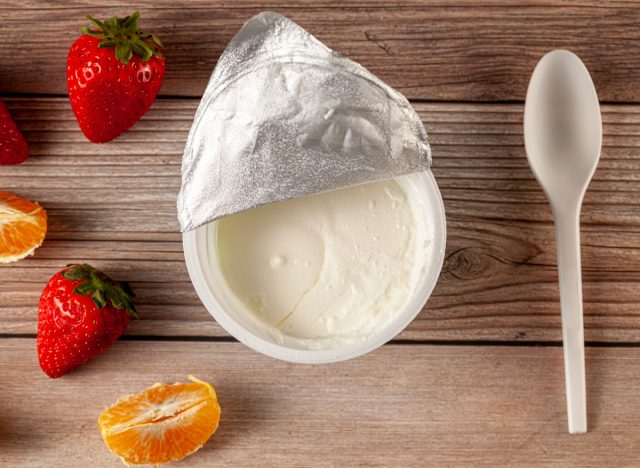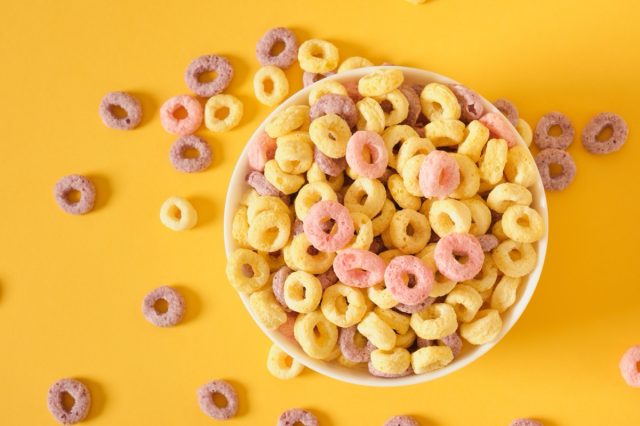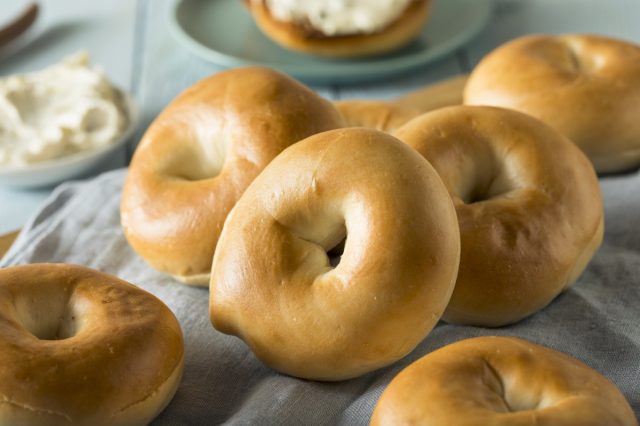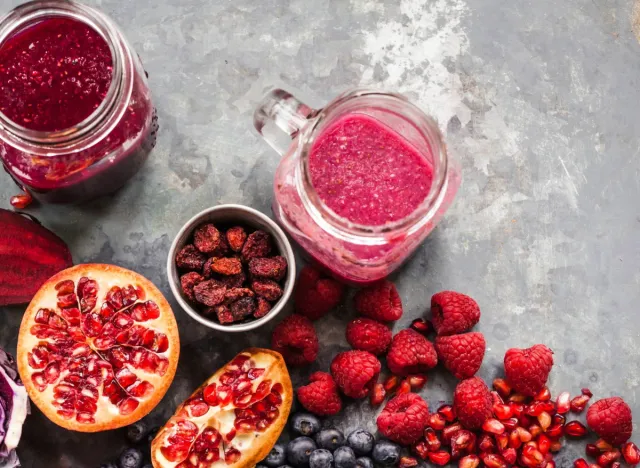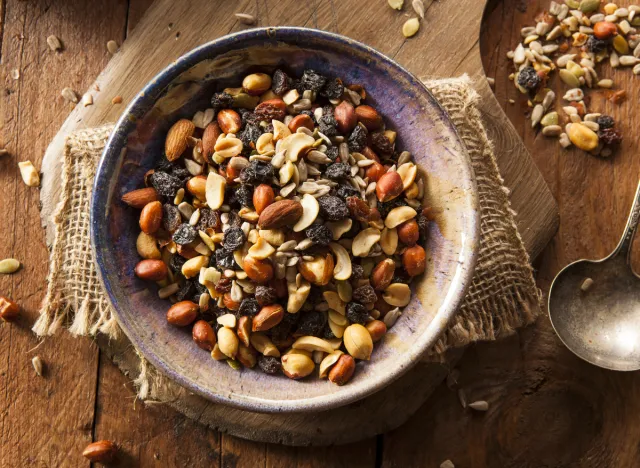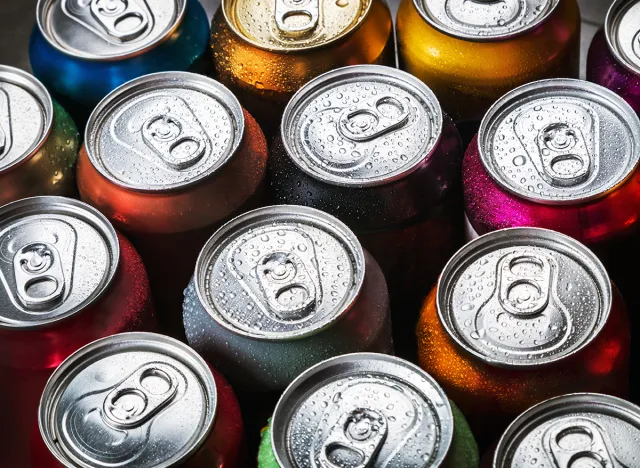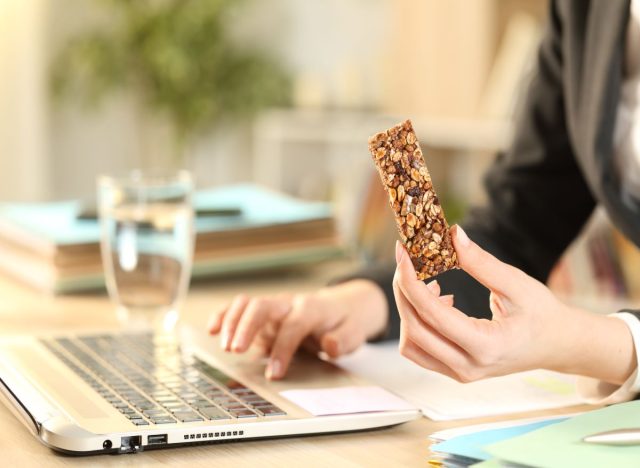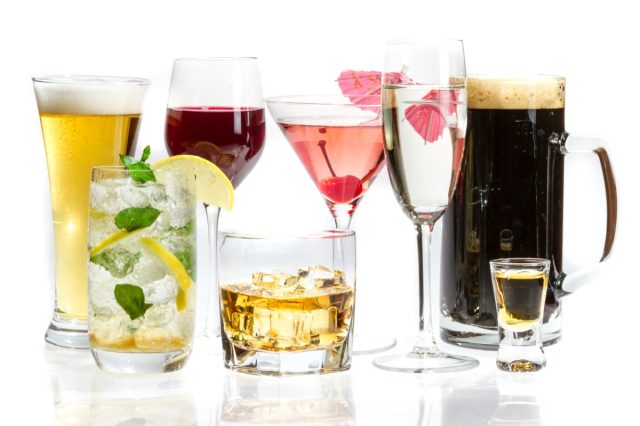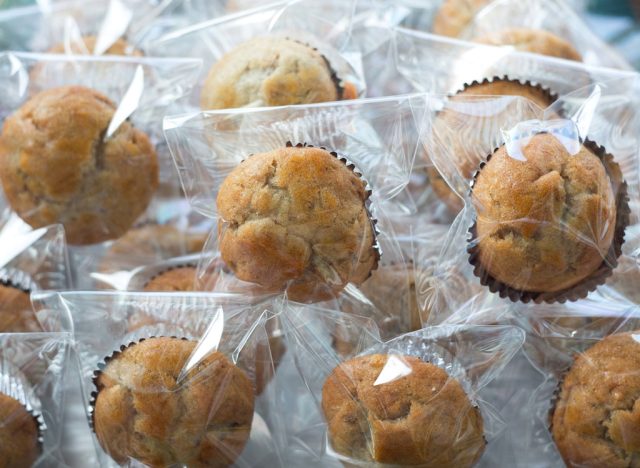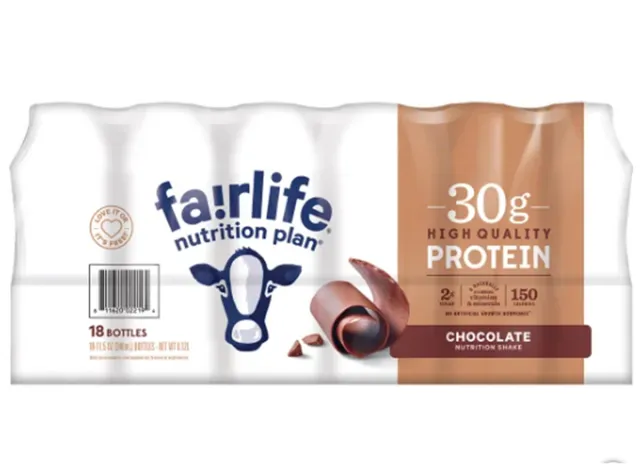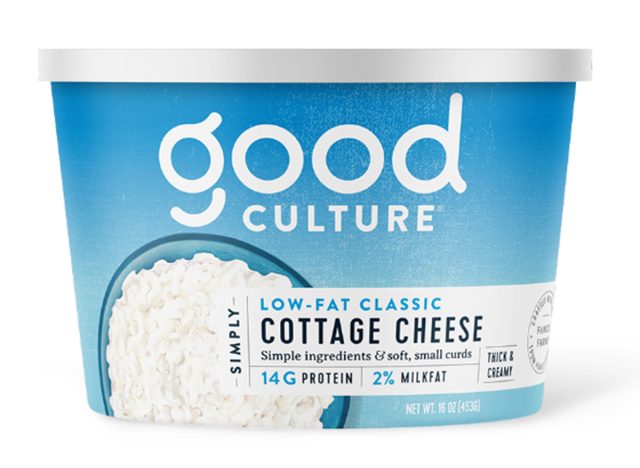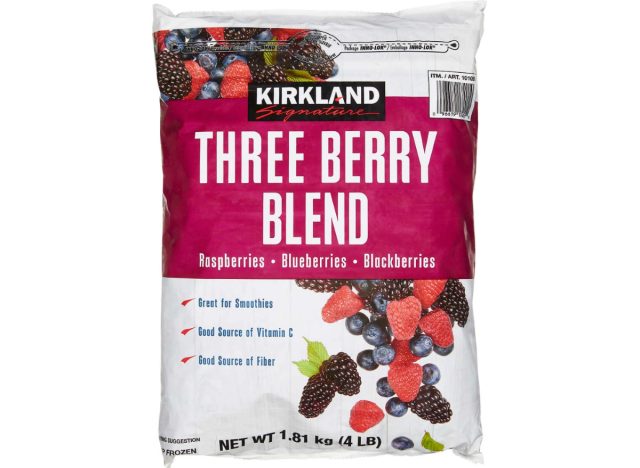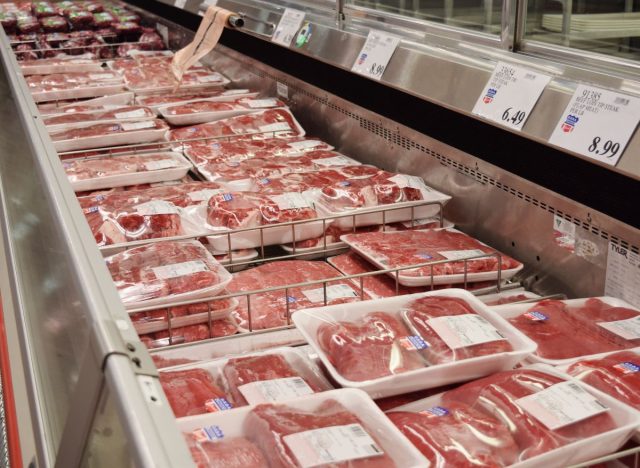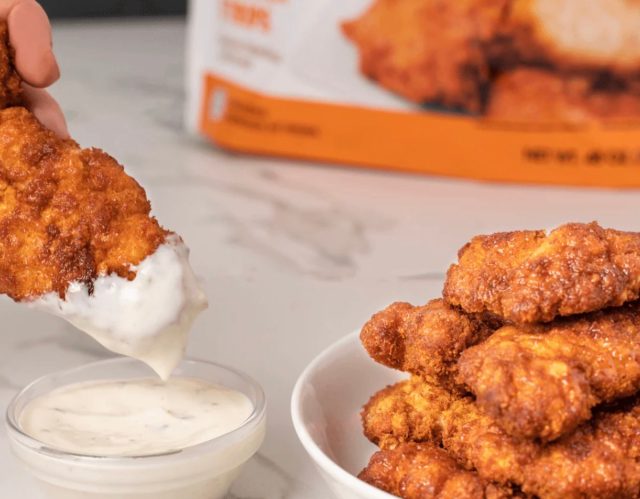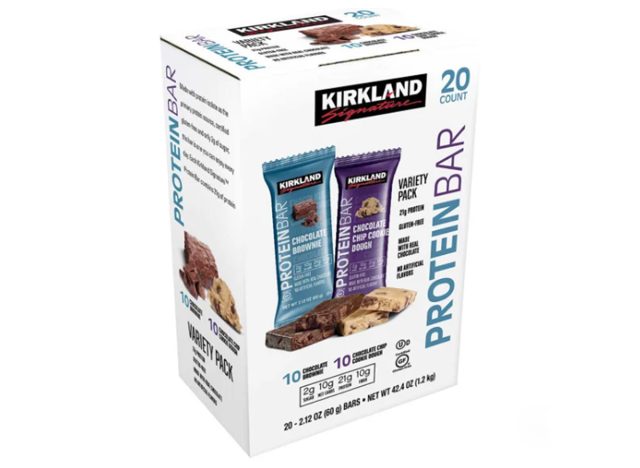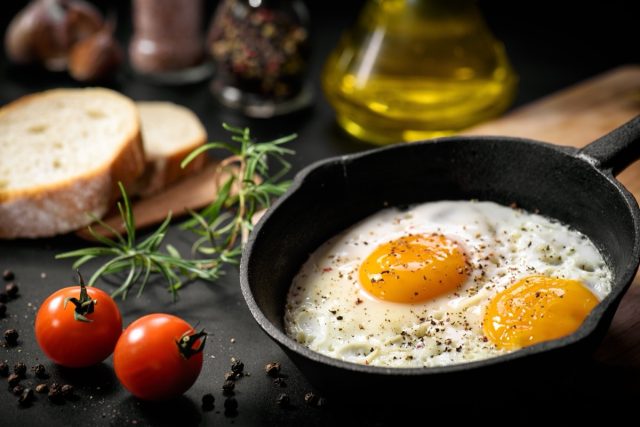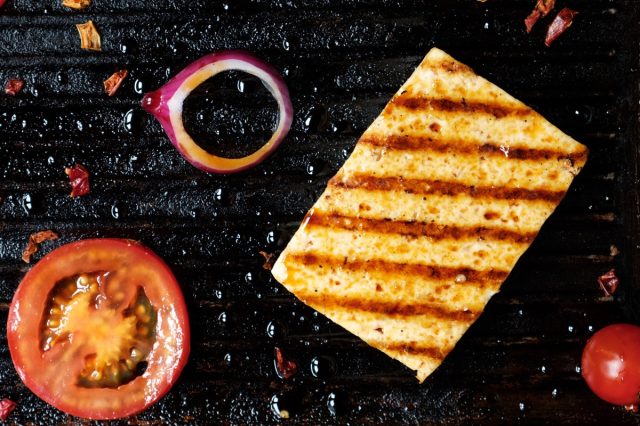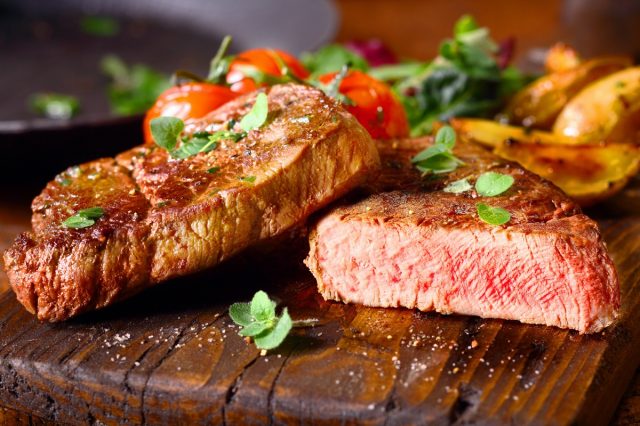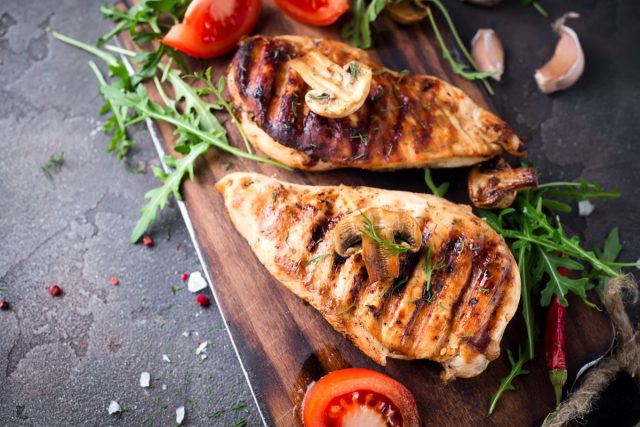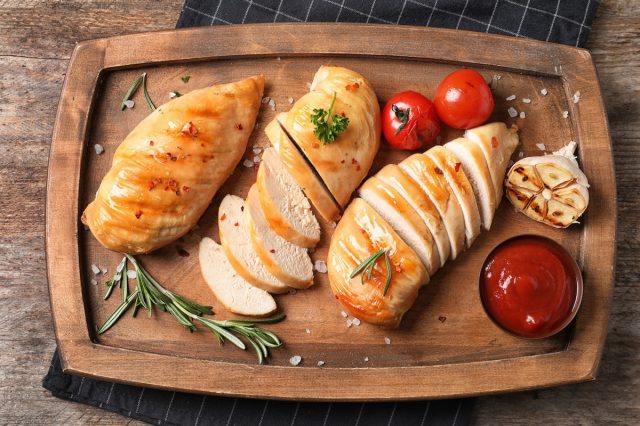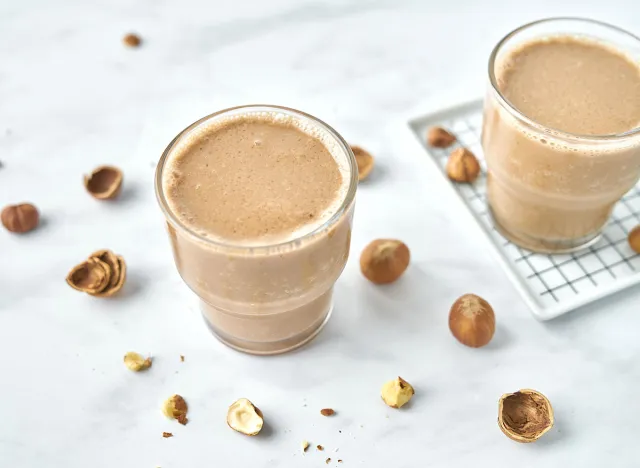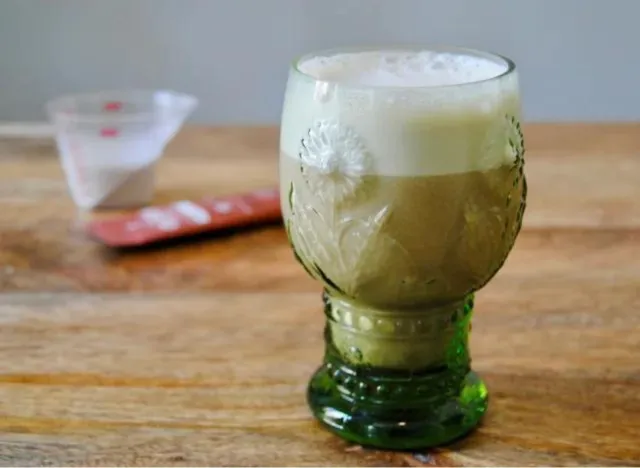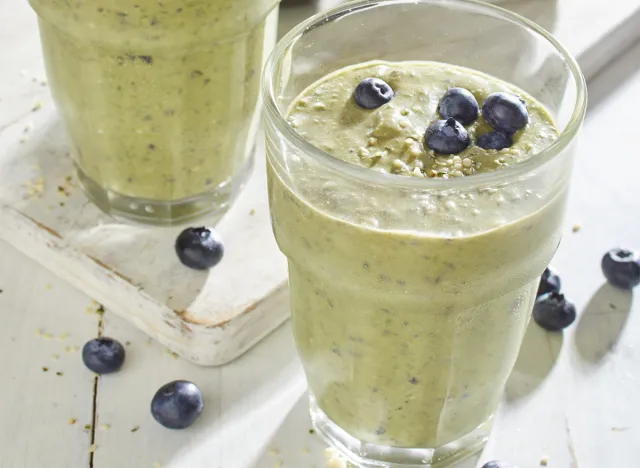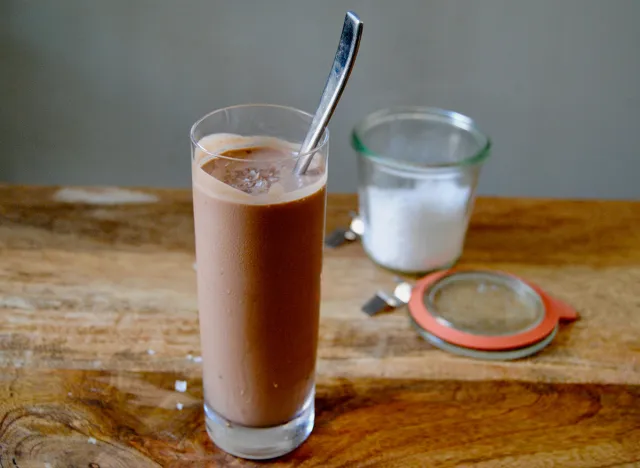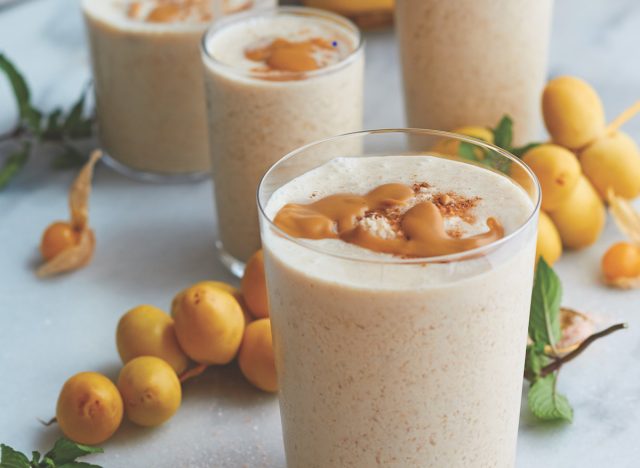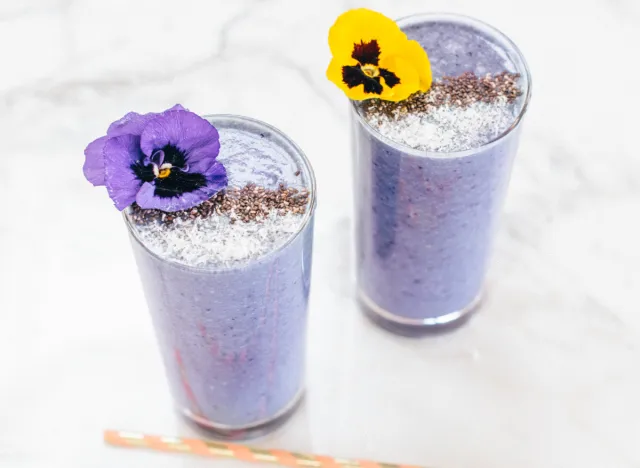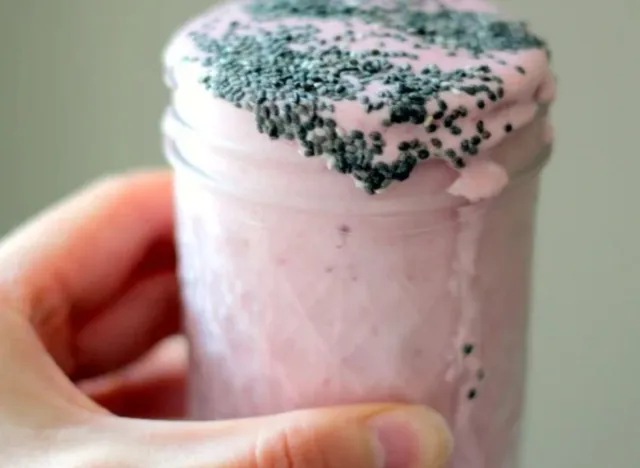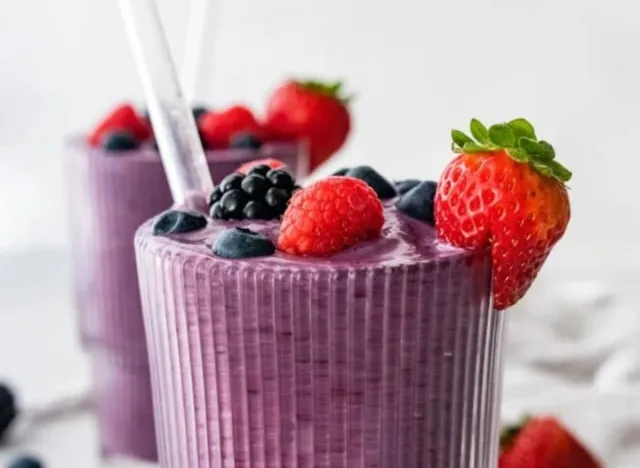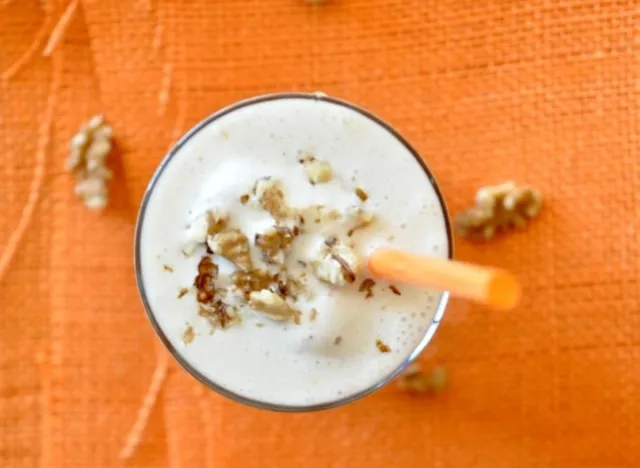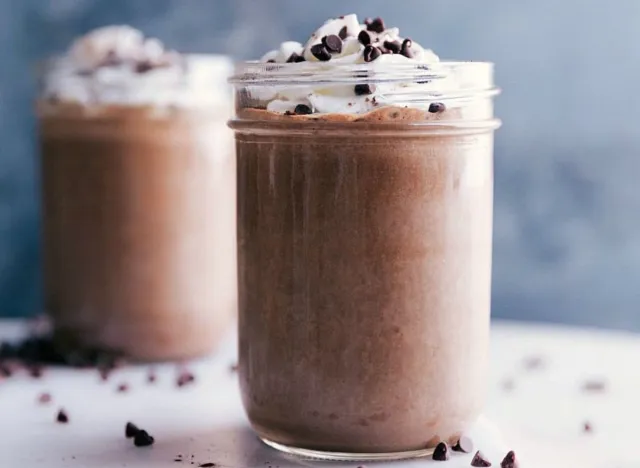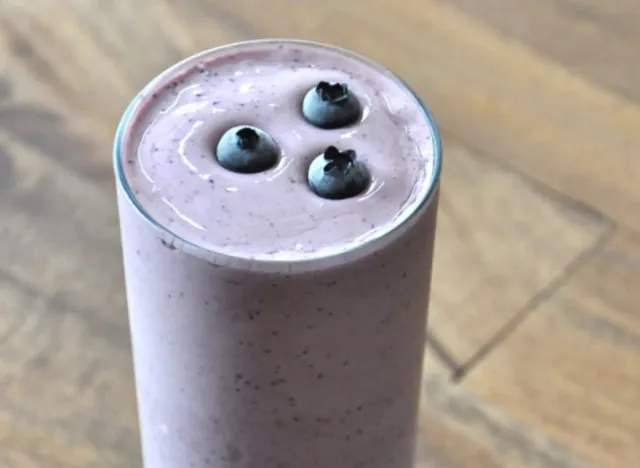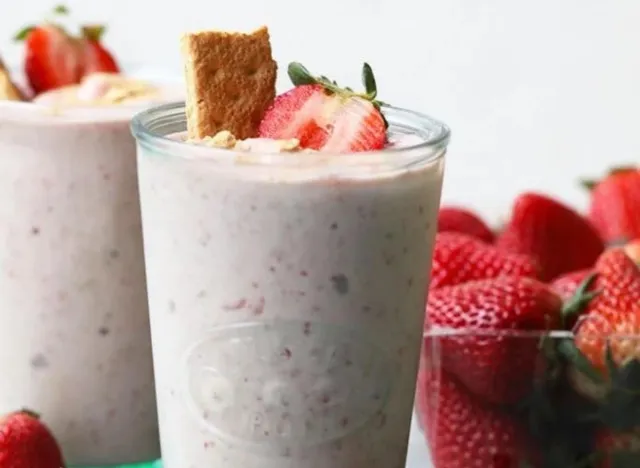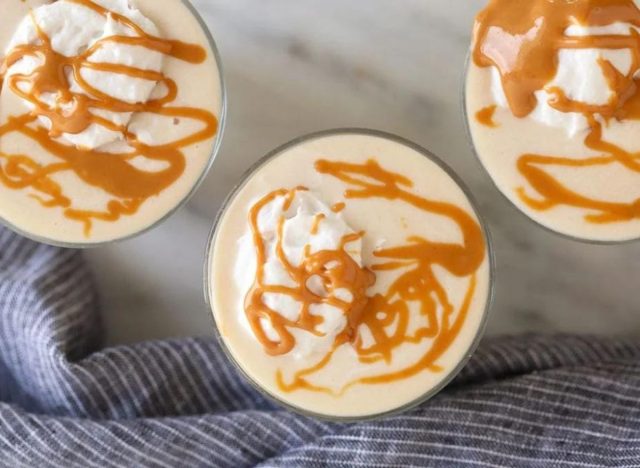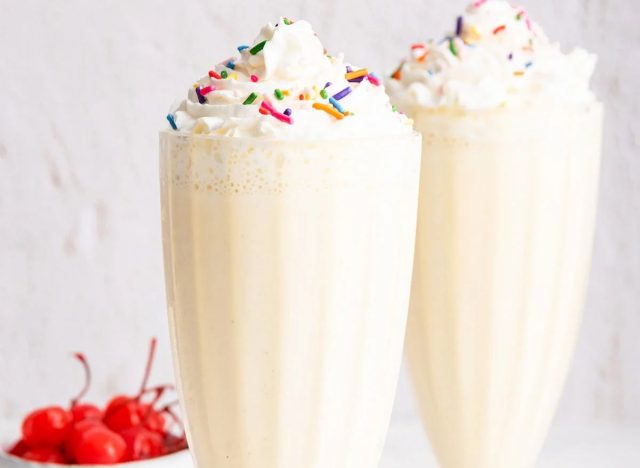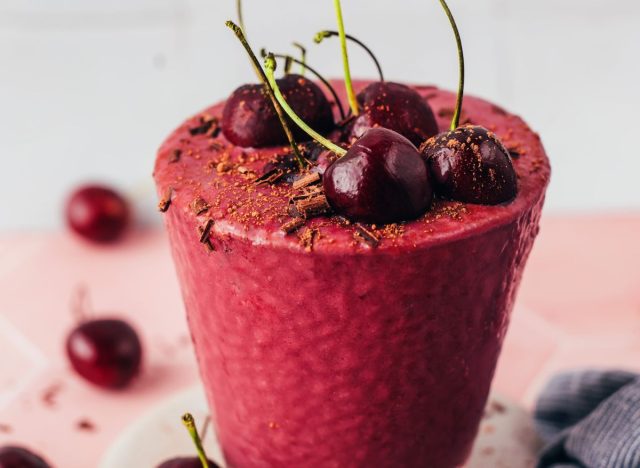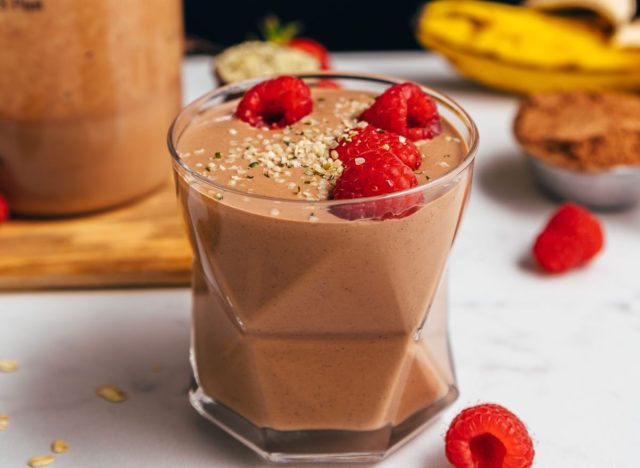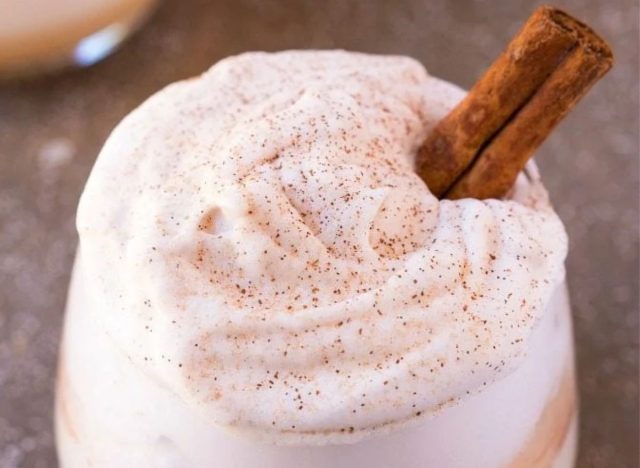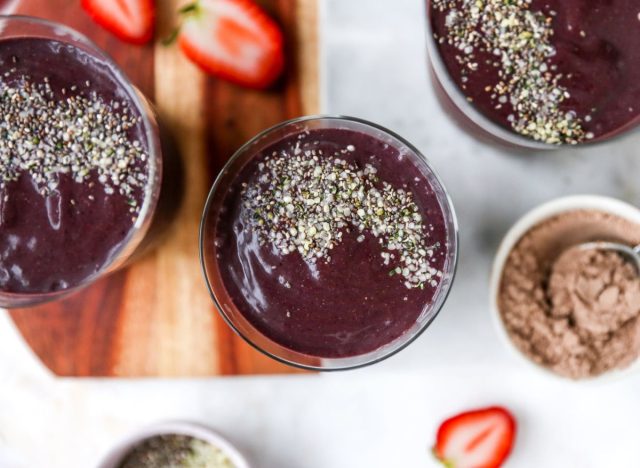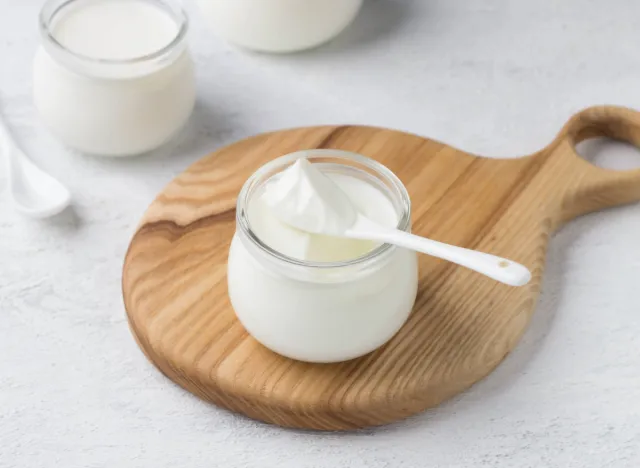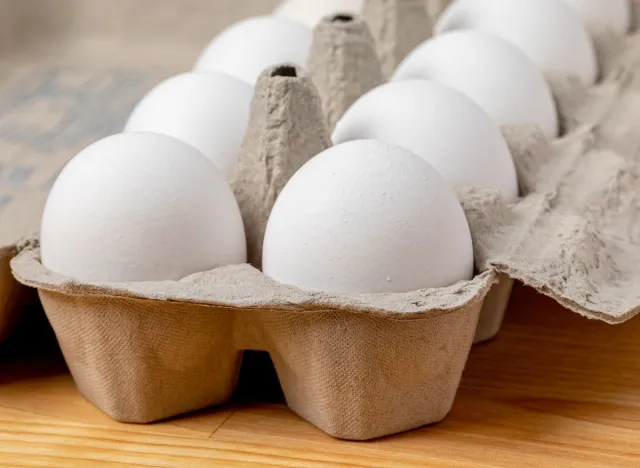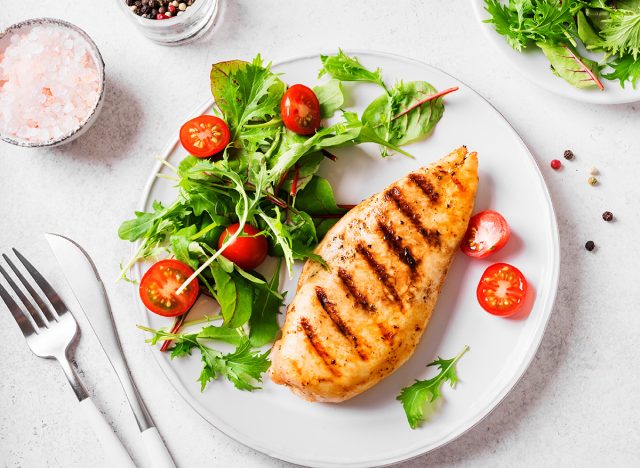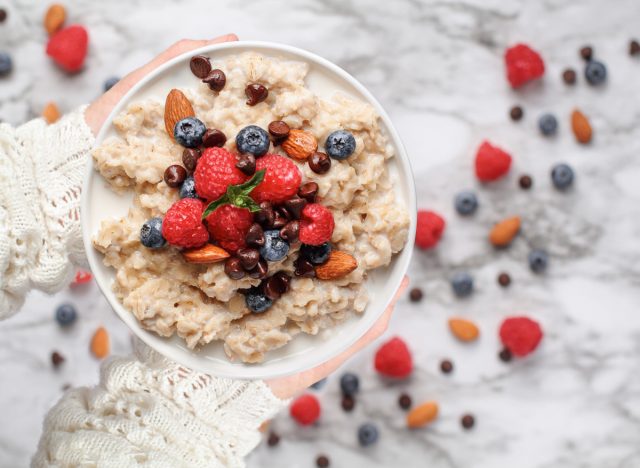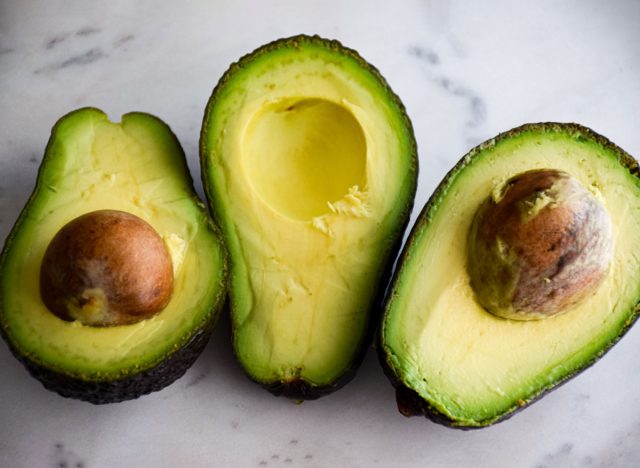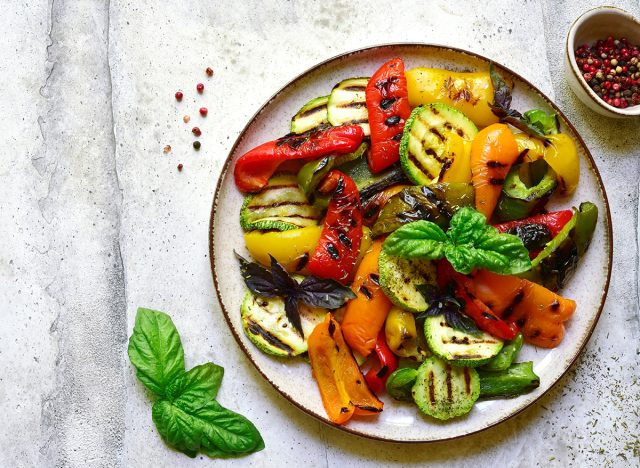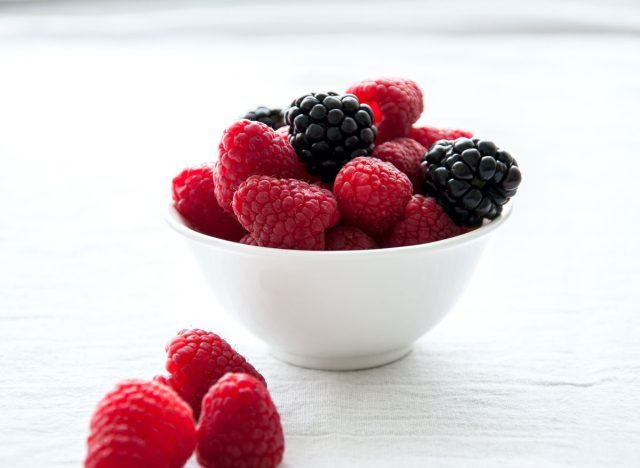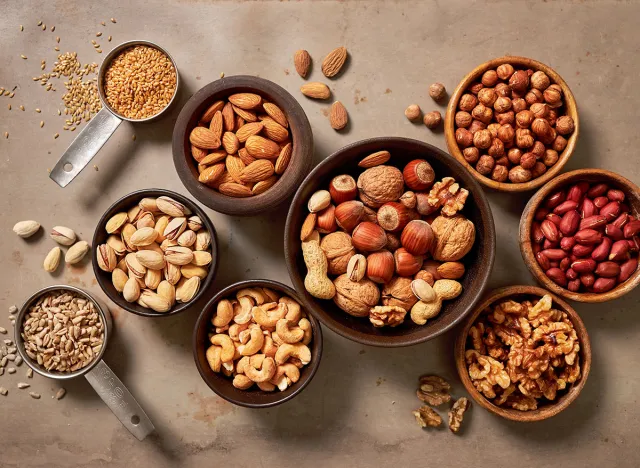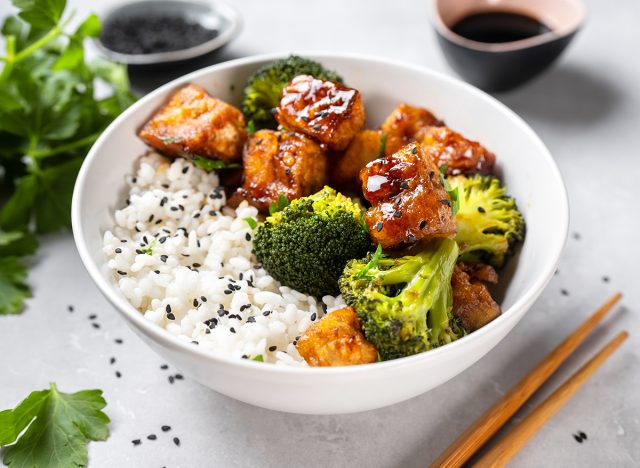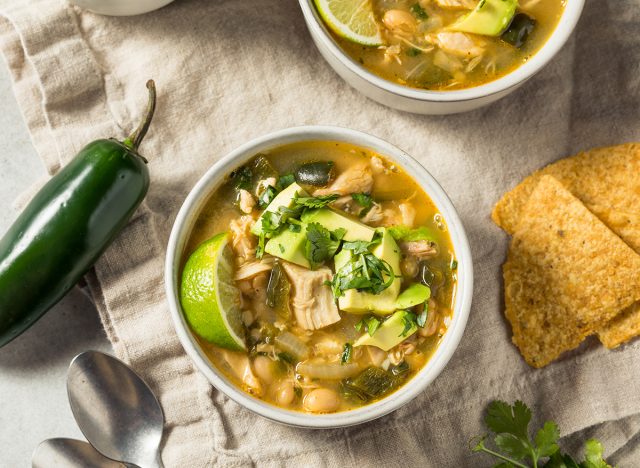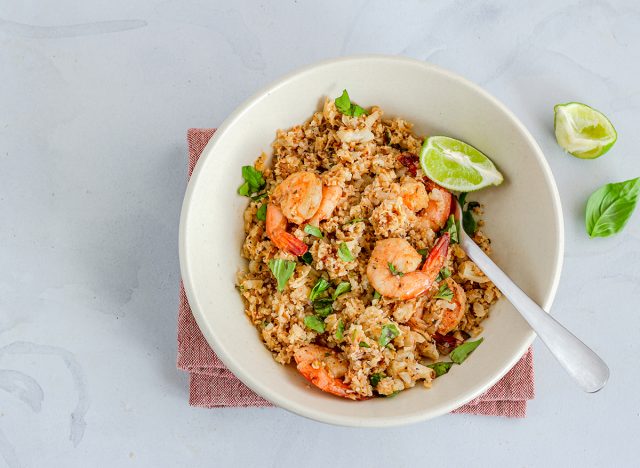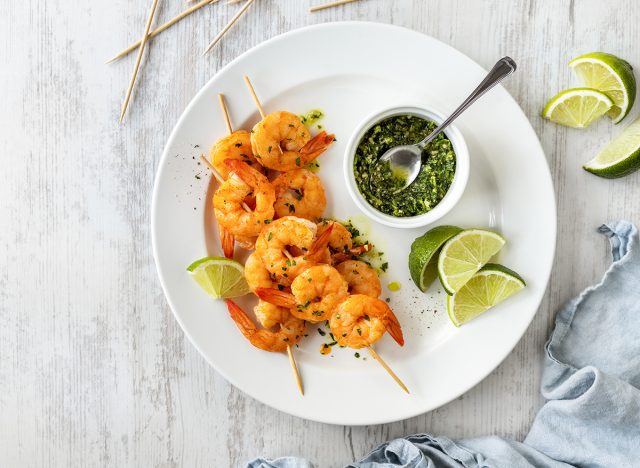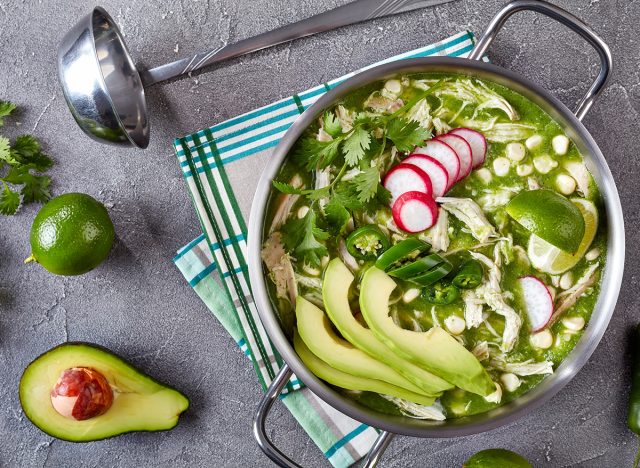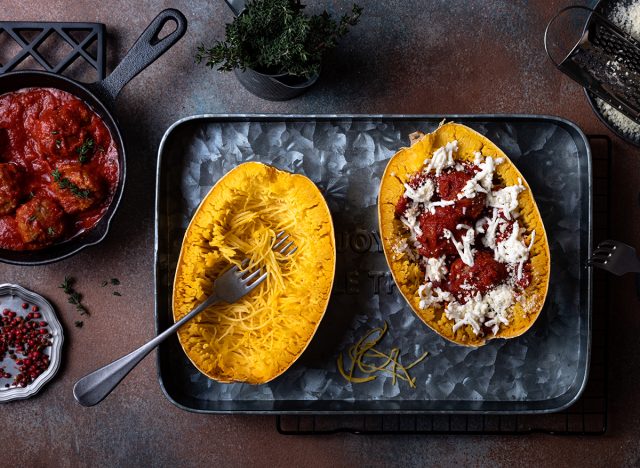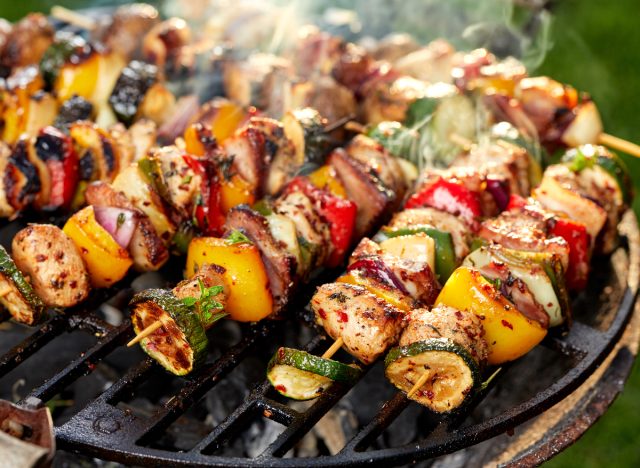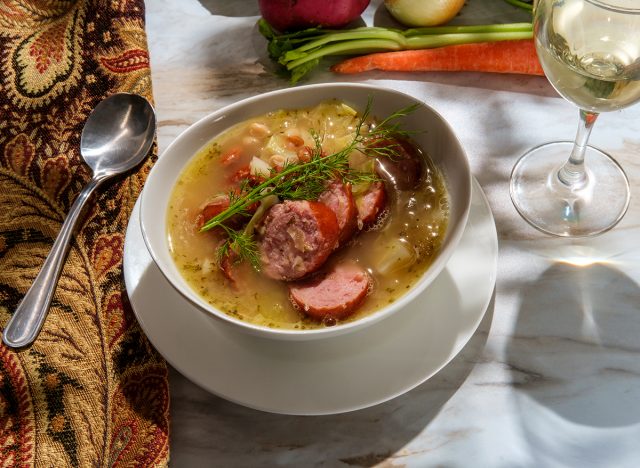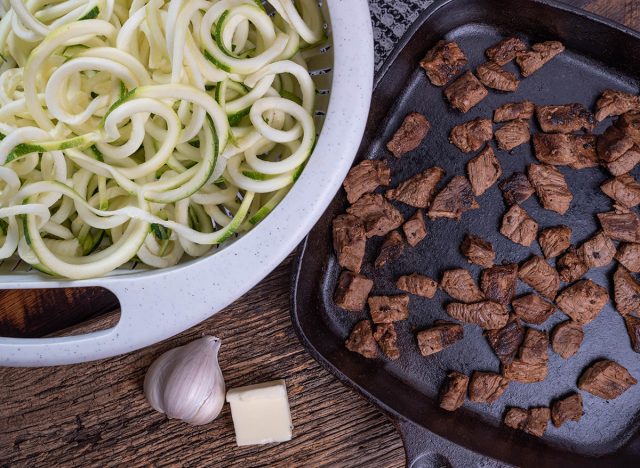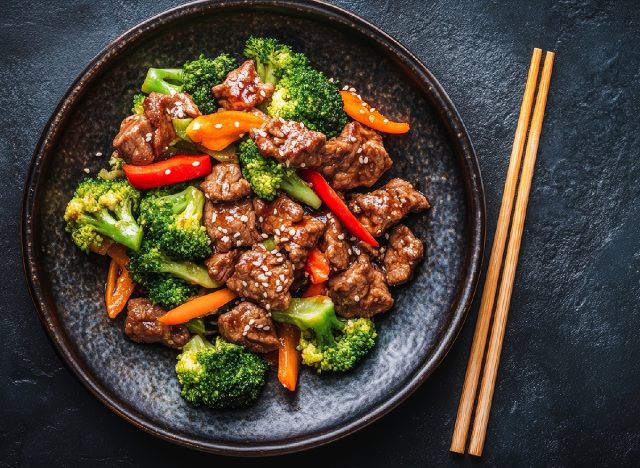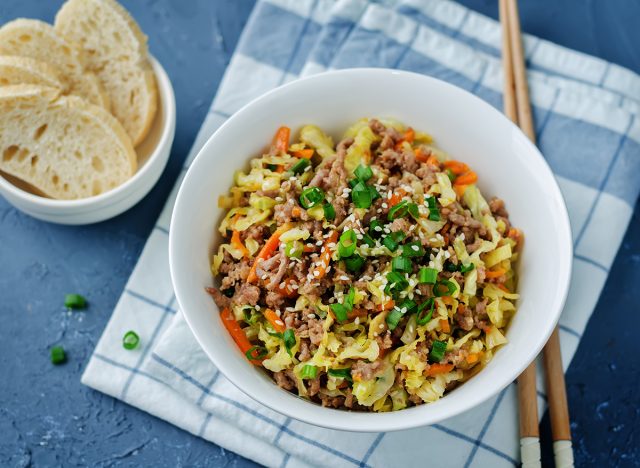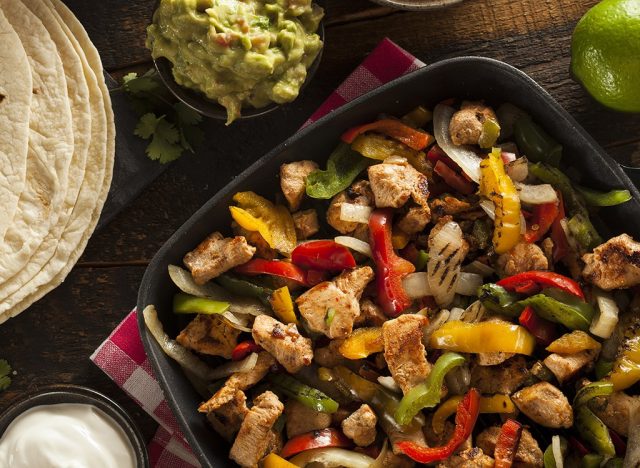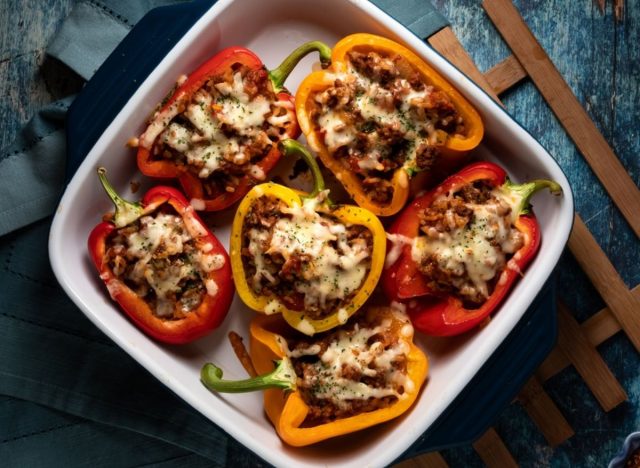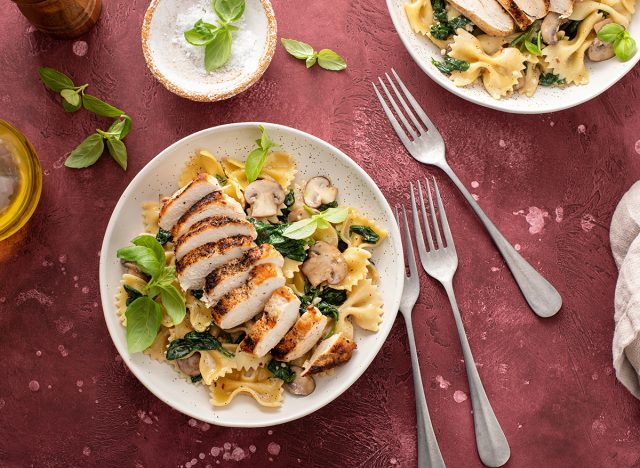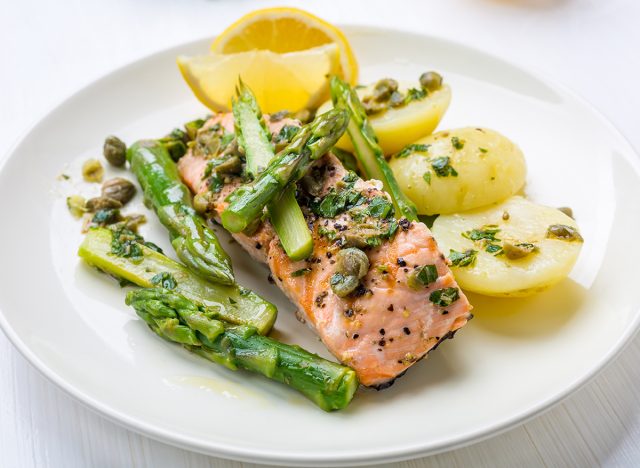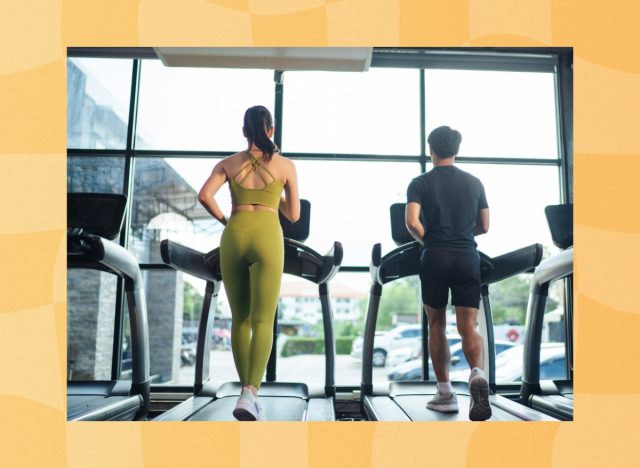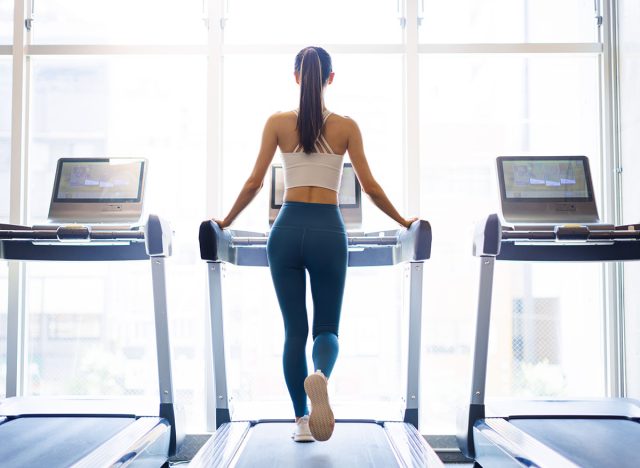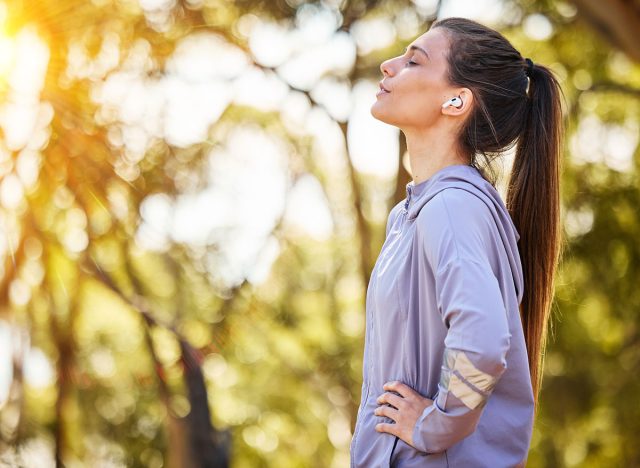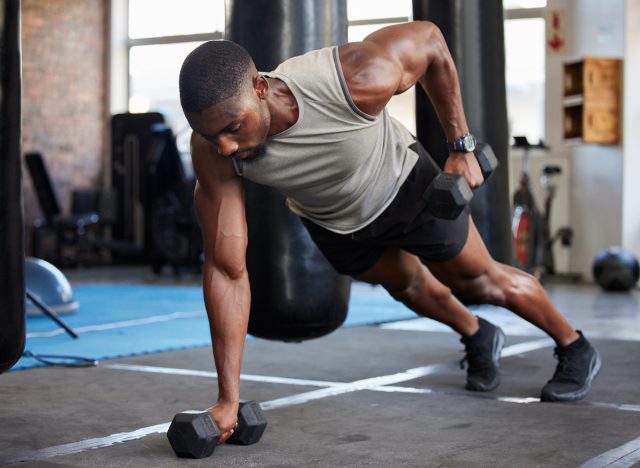Losing weight can be a grueling and frustrating process, especially if you're trying to do it in a safe and sustainable way. It can involve numerous lifestyle changes like eating differently, preparing meals ahead of time, and moving your body more on a daily basis. Because of how time-consuming and emotional this process can be, it can be utterly devastating when you're doing everything you can, only to realize you're not losing weight. Even if you've made some drastic changes to your diet, there are always going to be sneaky foods and drinks that we may not realize are contributing to some weight gain. At the end of the day, there isn't just "one food" out there that can cause us to gain weight, but eating certain types of foods with extra calories, fat, and added sugars may contribute to more weight gain and less weight loss over time. To help you get to the bottom of these food-related frustrations, we've highlighted 9 common foods and drinks that may be sneakily leading to problems with your weight loss goals. Flavored Yogurt
Yogurt can be an exceptionally healthy addition to your diet by adding protein, calcium, and probiotics. When shopping for yogurt, though, look out for flavored varieties that are loaded with added sugars, which can have upwards of 20-25 grams of added sugar per serving. According to the journal Nutrition, Metabolism and Cardiovascular Diseases, there is a powerful link between consumption of added sugar and weight gain, abdominal fat, and risk of obesity. When shopping for yogurts, look for healthier varieties like unflavored Greek yogurt or sugar-free flavored choices like Chobani Zero Sugar. Breakfast Cereal
Starting your morning off with cereal can be a great way to make sure you're still eating breakfast on busier days when there isn't time to cook something. However, many cereals are loaded with added sugars and contain little to no fiber or protein. Not only can too much added sugar contribute to weight gain, but not getting enough protein can leave you feeling hungry and unsatiated, which may lead to overeating later on. According to the Journal of Nutrition, individuals who don't eat enough protein are at greater risk of weight gain. A lack of fiber can also indirectly contribute to weight gain over time because you may not feel as full after eating, and according to the Journal of Nutrition, increasing your daily fiber intake can decrease your risk of weight gain. When picking a breakfast cereal that aligns with your health goals, look for healthier varieties that are low in added sugars and higher in fiber and protein. This will help you start your day off on the right foot. Bagels
Speaking of not getting enough fiber, regularly eating bread items made with white flour, like bagels, may contribute to weight gain. There are a couple of reasons for this. The first is the lack of fiber, as we mentioned with certain breakfast cereals. Fiber helps you stay satiated after eating, which can help ensure that you won't overeat later on. Beyond that, fiber helps improve your gut health, and research has shown that there is a strong link between a healthy gut microbiome and the ability to lose or manage your weight. Another factor to consider with bagels is that if you're eating a bagel by itself with something like cream cheese or butter, you won't be giving yourself any protein to help keep you full or maintain a speedy metabolism. And with the lack of fiber as well, a bagel will make you feel hungry quickly afterward. RELATED: 65 Healthy Weight-Loss Dinner Recipes for Busy Weeknights Smoothies
Smoothies have the potential to be a healthy part of your daily eating plan, but the ingredients inside a smoothie are what make or break its nutritional value. For example, drinking a smoothie you make at home that has protein, fiber, and lower fat can keep your calorie and sugar counts low while helping to keep you full until your next meal. Unfortunately, though, it's easy for smoothies to become sugar and calorie bombs when you include ingredients like sugary yogurts, too much nut butter, etc., or when you purchase pre-made bottles from the store. Trail Mix
This one is entirely dependent on the ingredients inside. If you're eating a trail mix that contains a balance of nuts, seeds, and fruit, you'll be giving your body a nutritious dose of protein, fiber, and antioxidants that will help to keep you full and satiated between meals. If your favorite trail mix happens to contain plenty of chocolate or sugary candy, though, it may sneakily increase your added sugar and calorie intake without you realizing it. To decide which is the best brand to buy for your health goals, check out our list of the healthiest and unhealthiest trail mix varieties on grocery store shelves. Soda
It's no secret that sodas are loaded with sugar, but we sometimes don't realize just how detrimental a daily soda habit can be to our health. In some of the sugariest bottles of soda, you can get anywhere between 75 and 85 grams of added sugar in one sitting—which is around three times the daily recommended limit set by the American Heart Association. Not only are these sugar-sweetened beverages harmful to your heart health, they're also potential culprits in weight gain because of all the added sweeteners. When you're craving something sweet and bubbly, try healthier soda alternatives that come with less sugar, like Olipop. RELATED: 10 Foods You Shouldn't Avoid if You Want To Lose Weight Granola Bars
This is a sneaky one because there are many granola bars out there that are healthy and full of nutrients. However, tons of bars market themselves as "healthy" and are, in fact, loaded with extra calories and sugar. If you've been snacking on a sugary granola bar in between meals or starting your day with one instead of a nutritious breakfast, you may be unknowingly contributing to some extra weight. Alcohol
If you feel like you've been eating super healthy but still aren't meeting your weight goals, it may be the alcoholic drinks you're sipping on at night. A glass of wine or two is fairly harmless every once in a while, but if you have a nightly habit of sipping on wine before bed or meeting friends out for a happy hour, you may be consuming more calories and sugar than you realize. Fat-free or "Diet" Foods
You may think that choosing fat-free or low-fat foods will automatically help you cut calories and lose weight, but it all depends on the food you're choosing. Some fat-free foods end up being loaded with added sugars to compensate for the lack of fat, which can quickly rack up your added sugar levels and contribute to weight gain. Fat-free salad dressings, low-fat ice cream, reduced-fat peanut butter, low-fat flavored yogurts, and low-fat cereals are all examples of grocery items that commonly come with higher levels of added sugar than their regular counterparts. The post 9 Everyday Foods That Could Be Secretly Making You Gain Weight appeared first on Eat This Not That. Медиа: | ↑ |
Whatever weight loss program you're following, whether it's keto, calorie counting, vegan, and more, Costco is pretty much guaranteed to have everything you could need. Shoppers who are on weight loss journeys frequently share their must-have weight loss products on social media, recommending their favorite protein sources, fruits, vegetables, and other healthy ingredients that make losing weight, even while on a strict budget, easier. If you're just starting a fitness routine and want some inspiration, here are seven Costco weight loss items that are a must-have. Fairlife Protein Shakes
Getting enough protein while losing weight is crucial for protecting lean muscle while burning fat. The Fairlife Protein Shakes ( $38.99 for 18) are a must-have, shoppers say. "Fairlife is the best protein shake I have ever had in my entire life. It's unbelievable. I buy them whenever I can find them at my Costco (there is a limit of 2 or I would buy more)," one shopper said. Good Culture Cottage Cheese
High in protein and low in calories, cottage cheese is an unsung weight loss hero. Costco shoppers are obsessed with the Good Culture Cottage Cheese whenever it can be found. "OMG I look for this every single time I'm there. I have to buy a million of the small containers from Whole Foods, I'd LOVE a 48 oz tub!" one Redditor said. Triple Berry Blend Mix
Costco members love the frozen Kirkland Signature Three Berry Blend mix ( $12.59 for 4 lbs) for making healthy smoothies. "I use the Vitamix Costco had on sale a few months ago to blend 150g of the triple berry blend, 50g of the mango chunks, 50g of the spring mix, a tablespoon of the hemp hearts, a scoop of one of their vanilla protein powders, and then about 18-20oz. of water. Great smoothie every morning using exclusively Costco items, and it makes two of their cups (one for me, one for my partner)," one Redditor shared. All the Meats
Costco's proteins are brought up frequently by people who are losing weight, from chicken to bison to beef and more. "I'm on a GLP-1. Things I eat from Costco are all the proteins," one Redditor shared. "Brisket. Chicken Breast. Eggs. Milk. Pork. Rotisserie Chicken. Steak. All. The. Protein. Protein powder and electrolytes could be on your list although I buy them elsewhere. I also get clothes because I've lost so much weight I need new clothes." Realgood Chicken Breast Strips
One Costco employee on a weight loss journey recommended the Realgood Lightly Breaded Chicken Strips for making healthy, protein-packed meals such as burritos. "I know I'm in the minority here but I liked these way more than the Kirkland chicken chucks," one Redditor said. "The Kirkland ones were way too salty. I admit that these are under seasoned but I just season it with generic dry wing seasoning and they are perfect." Frozen Vegetables
Costco's bags of fiber-packed frozen vegetables are a staple weight loss product to keep on hand, shoppers say. The Kirkland Signature Organic Normandy Vegetable Blend ( $12.99) is a big hit with members, as is the Pura Vida Fire Roasted Vegetable Melange. "Just got the Pura Vida one and it's my favorite ever," one Redditor said. Kirkland Protein Bars
The Kirkland Signature Protein Bars ( $26.49) are a convenient source of protein, shoppers say. "The correct answer is the Kirkland Protein Bar. You can't beat 21 grams of protein for 190 calories… I think they taste great too. But if it's more about taste, there are plenty of protein bars with more carbs and sugar that taste better. Health and cost wise though it's the Kirkland brand," one member said. The post 7 Best Costco Weight Loss Products Proven to Work appeared first on Eat This Not That. Медиа: | ↑ |
Visceral fat—also known as belly fat or abdominal fat, or is not like "normal" fat on the body—by its very placement it's more dangerous than fat which accumulates on the rest of the body (such as the buttocks or thighs). Not only is a large waistline linked to a host of alarming health conditions such as heart disease and diabetes, recent research shows high levels of visceral fat is associated with brain proteins which are " hallmarks" of Alzheimer's disease. "People with excess visceral fat also had evidence of greater insulin resistance and lower HDL (good) cholesterol levels, both of which may be connected in some way to brain amyloid deposition. Because of the participants' average age [50], the scientists suggested that excess visceral fat may be a signal of greater Alzheimer's risk before symptoms appear," says Harvard Health. "We can't precisely target where we lose every pound of weight, but it's important to reduce visceral fat," says psychologist and registered dietitian David Creel, PhD. "By losing 5% to 10% of your body weight, you can improve blood pressure, blood sugar, cholesterol levels, mobility, sexual function and more." A healthy diet is one of the most important lifestyle factors that impact belly fat, especially one high in protein, which helps build muscle while burning fat. Here are five proteins to include in your belly fat-blasting diet. Eggs
Eggs are expensive and hard to get right now thanks to the avian flu outbreak, but they really are effective in helping to blast belly fat. Each egg contains almost 7g of protein. A study published in Clinical Nutrition found that people who ate at least five whole eggs per week had "significantly" smaller waistlines, making eggs the ideal visceral fat-fighting food. "Participants reporting high egg consumption (five or more eggs a week) showed significantly lower body mass index, weight circumference and body fat mass percentage values and higher body lean mass percentage values than those reporting low egg consumption (less than one egg per week)…This finding is important from a public health perspective, suggesting that higher egg consumption (five or more eggs a week) may lead to a healthier body composition, especially due to higher protein intake." Tofu
100 g of tofu contains 17.3 g of protein, making it an excellent option for vegans and vegetarians. "It's a very nutritious food," Dr. Qi Sun, an associate professor of nutrition and epidemiology at Harvard T.H. Chan School of Public Health in Boston, tells the American heart Association. "Unlike animal sources of protein like beef, tofu is cholesterol-free," Romito Natalie Romito, RD, LD, tells the Cleveland Clinic. RELATED: The 10 Healthiest Proteins You Can Eat Salmon
Not only is salmon packed full of essential nutrients and omega-3s, 100g of wild salmon contains about 25 g of protein. "In the wild, salmon eat smaller fish that are high in EPA and DHA — the beneficial, long-chain omega-3 fatty acids," says Dr. Bruce Bistrian, professor of medicine at Harvard Medical School. Salmon also helps you keep full for longer, with is important for weight loss. Beef
Good quality beef is packed with nutrients such as iron, zinc, selenium, potassium, and vitamin B, and is an excellent whole-foods source of protein. 100 g of beef contains approximately 28.7 g of protein, making it a protein powerhouse. "When choosing beef — whether it's grass-fed beef or another type of beef — opt for lean beef," says Katherine Zeratsky, R.D., L.D., via the Mayo Clinic. "Lean beef has 10% fat or less. Grass-fed beef is generally more expensive than conventional grain-fed beef." Lean Chicken Breast
Both turkey and chicken are fantastic sources of protein, with 100 g of lean chicken breast containing 32.1 g of protein and 100g of lean ground turkey containing 28 g of protein. "Both chicken and turkey are truly excellent choices for health conscious consumers and both deserve a spot on your plate," says Frances Largeman-Roth, RDN, via TODAY. "But if you prefer dark meat and you're trying to max out your daily protein intake, then turkey edges out chicken by a wing. Plus, it contains more choline, a nutrient that's vital for brain health and memory." The post The #1 Proteins to Reduce Visceral Fat, Ranked by Effectiveness appeared first on Eat This Not That. Медиа: | ↑ |
As we age, weight management becomes increasingly challenging. Hormonal changes, slowing metabolism, and other factors can make it seem like our bodies are working against us. As a longevity doctor specializing in metabolic health, gut function, and hormones, I've helped countless patients over 50 navigate their weight management journey, including those using medications like Ozempic. What I've discovered is that many people make critical mistakes that can undermine their health goals. Read on to learn how to avoid these common pitfalls and use these medications effectively. Why Ozempic Has Become Popular Among Adults Over 50Adults over 50 are turning to medications like Ozempic because as one gets older, the metabolism decreases and other factors that include insulin resistance, hormonal changes, and low muscle mass make it harder to lose weight. Most people over 50 years of age use Ozempic since diet and exercise no longer help them keep the weight off the same way it used to when they were young. Many people in this age group are interested in preventing the development of different chronic diseases including diabetes and heart disease as well. How does Ozempic work? It works by mimicking a hormone called GLP-1, which regulates blood sugar and appetite. However, in older adults, these effects can be rather enhanced. The delayed gastric emptying that is associated with Ozempic use puts the patients at risk of malnutrition if they do not watch their nutrient intake. Also, the gut is involved in the production of some neurotransmitters such as serotonin and endorphins, hence altering this system results in anxiety and depression. RELATED: 8 Foods to Eat on Ozempic and 4 to Avoid The Biggest Challenges With Ozempic For People Over 50As a longevity doctor, what I aim to achieve is to enhance health, prolong life, and enhance the quality of life as people grow older. I specialize in metabolic health, the gut, and hormones, all of which are very important for successful aging. Many people over 50 face weight gain, insulin resistance, and inflammation, that's why they often turn to medications like Ozempic to assist them. One of the biggest issues I see with my patients over 50 using Ozempic is a lack of understanding of how the medication works, how severe the risks are, and what lifestyle changes need to be made with it. Some people think it's a quick solution, but if they don't follow the right nutrition and exercise plan, they can experience muscle loss, malnutrition, and many other long-term health complications. Another major problem is that this medication affects mental health; it has been proven that GLP-1 medications cause anxiety, depression, or mood swings. Mistake: Not Eating Enough Protein and Nutrient-Dense Foods
Why it happens: Because Ozempic reduces appetite, many people end up eating significantly less without paying attention to nutrient quality. While eating less can help with weight loss, it can also lead to muscle loss and nutrient deficiencies if people aren't intentional about their diet. Potential health consequences: Loss of muscle mass (sarcopenia) is a major concern, particularly for older adults. This can lead to weakness, frailty, and a slower metabolism. Inadequate nutrient intake can also cause fatigue, poor immune function, and hair loss. How to avoid it: Prioritize high-quality protein at every meal, such as eggs, fish, poultry, lean meats, and plant-based proteins. Nutrient-dense foods like leafy greens, healthy fats, and fiber-rich vegetables should also be a focus. Warning signs to watch for: Feeling weak, experiencing more fatigue than usual, noticing increased hair shedding, or struggling with poor digestion could be signs of malnutrition. RELATED: 5 Walking Techniques That Burn More Fat Than Running Mistake: Ignoring Mental Health Risks
Why it happens: Many people don't realize the connection between gut health and mental health. Since Ozempic affects digestion and gut function, it can disrupt the production of neurotransmitters like serotonin and endorphins. Research has linked GLP-1 receptor agonists like Ozempic to an increased risk of anxiety and depression in some individuals, particularly those with a history of mood disorders. Potential health consequences: Mood disturbances, including depression, anxiety, and even suicidal ideation, have been reported in some people using Ozempic. This is particularly concerning for individuals already prone to mental health challenges. How to avoid it: If you have a history of anxiety or depression, speak with your doctor before starting Ozempic. Support mental health by ensuring you're getting enough omega-3s, vitamin D, and B vitamins, and consider incorporating probiotics to support gut-brain communication. Staying active and maintaining strong social connections can also help mitigate mental health risks. Warning signs to watch for: Increased feelings of sadness, loss of motivation, social withdrawal, heightened anxiety, or trouble sleeping could indicate that the medication is negatively affecting your mood. If you notice these, consult your doctor immediately. Mistake: Using Ozempic Without Strength Training
Why it happens: Many people assume weight loss equals better health, but without strength training, much of the weight lost is muscle, not just fat. Potential health consequences: Loss of muscle mass leads to a slower metabolism, increased risk of falls, decreased bone density, and long-term mobility issues. How to avoid it: Incorporate strength training at least 2-3 times a week. This doesn't mean heavy lifting—even bodyweight exercises, resistance bands, or light dumbbells can make a big difference. Pairing strength training with adequate protein intake will help preserve muscle. Warning signs to watch for: If you're losing weight but noticing increased flabbiness, fatigue, or a decrease in overall strength, you may be losing muscle instead of fat. RELATED: 7 Simple Daily Exercises To Shrink Hanging Belly Fat The Right Way to Combine Nutrition and Exercise With OzempicNutrition and exercise are vital for maximizing the benefits of Ozempic and preventing long-term health complications. The medication alone isn't enough—without proper nutrition, people risk muscle loss and nutrient deficiencies. I recommend a high-protein, whole-food diet with an emphasis on fiber, healthy fats, and anti-inflammatory foods. Exercise is just as important. Strength training helps preserve muscle mass, while walking and other forms of movement improve insulin sensitivity and cardiovascular health. Yoga, pilates, and stretching routines can also help maintain flexibility and mobility as people age. The combination of strength training, movement, and proper nutrition is what will lead to long-term success. What Results Can You Realistically Expect?Most people can expect to lose 1-2 pounds per week when using Ozempic correctly. More importantly, they may see improvements in blood sugar regulation, reduced inflammation, and better overall metabolic health. However, results will vary based on lifestyle factors—those who focus on muscle preservation and a nutrient-dense diet will have better long-term outcomes than those who simply rely on the medication to suppress appetite. It's also important to note that weight loss medications are not permanent solutions. If people don't make sustainable lifestyle changes, they risk regaining the weight once they stop taking the medication. RELATED: Are Your Workouts Making You Store More Fat? 6 Exercises To Avoid Expert Advice for Getting Started With Ozempic After 50If you're considering Ozempic, go in with a strategic plan. Speak to your doctor about potential risks, especially if you have a history of mood disorders. Prioritize nutrition, making sure you're eating enough protein and essential nutrients. Strength training and regular movement should be part of your routine to preserve muscle mass. Also, listen to your body. If you notice digestive discomfort, mood changes, or a decrease in energy, take it seriously and make adjustments as needed. And most importantly, remember that Ozempic is a tool, not a cure-all. The real key to longevity and lasting health is building sustainable habits that support your overall well-being. The post 3 Ozempic Mistakes That Could Wreck Your Health After 50 appeared first on Eat This Not That. Медиа: | ↑ |
If you want to lose weight in a sustainable, safe, and effective way, drinking protein shakes can help you get there. Unfortunately, many protein shakes are either loaded with sugar or lacking in flavor. Thankfully, with the right recipes, your weight-loss protein shakes can be so delicious you'll want to drink them every day. How do protein shakes help with weight loss?So, how exactly can protein shakes help you meet your weight loss goals? It mainly comes down to the benefits of protein itself. According to Lisa Young, PhD, RDN, "Protein helps you to feel full, so you can feel satisfied and stop eating, and it also helps to preserve lean muscle, which correlates to your metabolism (the faster your metabolism, the faster you burn calories)." For many people, getting enough protein throughout the day can be challenging. This is where protein shakes come in handy. They are convenient, easy to sip on the go, and allow you to control how much protein you're getting in one serving. You can buy ready-made protein shakes from the store or make your own at home using high-protein ingredients like Greek yogurt (10 grams), protein powder (20-25 grams), milk and soy milk (8 grams), and nut butter (7 grams). How much protein should be in your shake?This number depends on your individual goals, how much protein you're aiming to get daily, and whether you're using it as a snack or a meal replacement. If you're drinking a protein shake as a meal replacement, you'll want to aim for no less than 30 grams of protein, but somewhere between 35-4o is better. If you're using it as a snack, the protein amount truly depends on the daily amount you're aiming for and how much you're getting at breakfast, lunch, and dinner. For example, let's say you're aiming for 125 grams of protein per day, and you get around 30 grams of protein per meal. At this rate, you could benefit from a protein shake that has around 30-35 grams of protein. If you're unsure about how much protein you should eat in a day, talk with your doctor or a dietitian for guidance. And Now for the 20 Best Protein Shakes for Weight LossChocolate Hazelnut Smoothie
This one is for the Nutella lovers. Made with hazelnut chocolate milk, banana, frozen cauliflower rice (for creamy texture), and protein powder, this protein-rich drink is a sweet treat that avoids added sugars and comes packed with plenty of nutrients. Your sweet cravings will feel satisfied, and you'll stay full until your next meal with this chocolate hazelnut beverage. Get our recipe for Chocolate Hazelnut Smoothie. RELATED: 12 Best Store-Bought Protein Shakes Paleo Iced Coffee Protein Shake
Protein can certainly leave you feeling full, satisfied, and energized, but what is even better when it comes to giving your body a boost of energy? The combination of both protein and caffeine. In this Iced Coffee Protein Shake, you'll get a caffeine surge for instant energy and the staying power of protein to sustain you throughout the rest of the afternoon. This shake is also Paleo-friendly, which works for those following the Paleo diet. Get our recipe for Iced Coffee Protein Shake. Meal-Replacement Paleo Protein Shake
You can sometimes use protein shakes as meal replacements, as long as they have enough protein and calories, as well as other helpful nutrients like fat and fiber to balance it out. This meal-replacement protein shake recipe uses protein powder, banana, coconut yogurt, almond milk, berries, spinach, and chia seeds, so you're getting a well-balanced beverage in every glass. This recipe is also Paleo-friendly, but if you're not following a Paleo eating plan and can consume dairy, you can switch out the coconut yogurt and almond milk for dairy products for even more protein. Get our recipe for Meal-Replacement Shake. RELATED: 13 Superfood Smoothie Recipes To Start Your Day Right Green Keto Shake
So this one technically isn't called a "protein shake" because the recipe doesn't call for protein powder. Still, it made our list because with protein powder added, it becomes a well-rounded drink full of fiber, healthy fats, protein, and antioxidants. And if you're following a Keto diet, this shake can meet your higher-fat, lower-carb needs. However, we recommend you talk with a doctor or dietitian before starting a Keto eating plan. Get our recipe for Green Keto Shake. Tahini Chocolate Shake
You've heard of using avocado or yogurt for extra creaminess in your shakes, but what about tahini? This condiment has a nutty, earthy flavor and adds a dose of creaminess to your favorite protein drink. This recipe doesn't call for protein powder, but you can always add in your favorite scoop for a chocolatey protein boost. This recipe is also low in sugar, using only dates to sweeten it. Get our recipe for Tahini Chocolate Shake. Kefir Smoothie
Kefir is a fermented drink that provides probiotics, vitamins, and protein. This Kefir recipe is unique on our list in that it provides enough protein from the kefir alone ( about 12 grams) and doesn't need protein powder added. Those who are watching their sugar intake will appreciate that the sweetness in this drink comes only from dates. Get our recipe for Kefir Smoothie. RELATED: 30 High-Protein Snacks To Stay Full and Energized All Day Berry Cauliflower Smoothie
One of the best ingredients you can add to any protein shake or smoothie for a super-creamy texture is frozen cauliflower. With blueberries, chia seeds, peanut butter, and vanilla protein powder, all added in with some frozen cauliflower florets, you'll have a protein-heavy drink that also includes healthy fats, fiber, and antioxidants. Get this recipe for Berry Cauliflower Smoothie via Tone It Up. RELATED: 11 Best Vegan Protein Powders for Building Muscle Strawberry Chia Seed Protein Shake
The best type of protein shake you can make is one that not only packs in the protein but also offers other healthy ingredients that can give your body a boost of different nutrients. This protein drink from Ambitious Kitchen meets the mark because it combines protein powder, almond milk, strawberries, and chia seeds. Chia seeds are a surprisingly nutritious powerhouse, offering up healthy fats, fiber, and protein—all of which can help keep you full until your next meal. Get the recipe from Ambitious Kitchen. Pumpkin Protein Shake
Don't wait until the fall season to enjoy this Pumpkin Protein Shake. Made with protein powder, cashew butter, banana, almond milk, and pumpkin puree, it provides a huge boost of protein and plenty of fiber from the pureed pumpkin. Fiber is a nutrient that can help increase satiety and keep you full longer, so including fiber-rich ingredients in your protein shakes can increase the staying power even more—the perfect component for a weight loss shake. Get the recipe from Eating Bird Food. RELATED: 25 Ways To Eat More Protein Without Overhauling Your Diet Vegan Protein Shake
A lot of protein shakes use animal products like whey protein and dairy milk, but it's just as easy and effective to make a vegan protein shake like this one from Eating Bird Food. Using plant-based vanilla protein powder, almond milk, spinach, mixed berries, almond butter, and chia seeds, this shake does more than just give you a protein boost. With the spinach and mixed berries, you're also getting fiber, vitamin C, vitamin K, iron, and plenty of other helpful nutrients that can improve your overall health. Get the recipe from Eating Bird Food. RELATED: 25 Best-Ever Weight Loss Smoothies Honey and Spiced Walnut Shake
This Walnut and Honey Spiced Shake from Minimalist Baker is the perfect choice for a super creamy, super indulgent protein shake that still gives your body a big boost of nutrients. It blends cottage cheese, protein powder, walnuts, cardamom, and vanilla, which yields a flavorful, protein-rich treat you'll want to eat anytime throughout the day. Cottage cheese may sound strange as a smoothie or shake ingredient, but this low-fat, high-protein cheese provides a creamy texture and 12 grams of protein per 1/2 cup. Get the recipe from Minimalist Baker. Chocolate Protein Shake
You usually can't go wrong with "chocolate" in the name, and this protein shake recipe uses chocolate wherever it can. This combination of almond milk, almond butter, banana, chocolate protein powder, and cocoa powder will instantly satisfy your sweet cravings but will keep you feeling full for hours. Get the recipe from Chelsea's Messy Apron. RELATED: The 10 Unhealthiest Protein Shakes on Grocery Shelves Blueberry Maple Protein Shake
Some people may think of protein shakes as just protein powder, milk, and ice. Still, as you can see from our list, protein shake recipes can include other flavorful, nutritious ingredients like fruit, veggies, nuts, seeds, and natural sweeteners. This recipe from Minimalist Baker is a great example, using blueberries, yogurt (or cottage cheese), maple extract, and the protein powder of your choice to deliver a burst of flavor and staying power. Get the recipe from Minimalist Baker. RELATED: 25 High-Protein, Low-Carb Recipes To Keep You Full Strawberry Protein Shake
Take a handful of frozen strawberries, some protein powder, Greek yogurt, and graham crackers, and you'll have yourself a protein shake that looks, tastes, and feels like a McDonald's strawberry milkshake—minus the crazy amounts of added sugar. Get the recipe from Fit Foodie Finds. Healthy Banana Protein Shake
This banana protein shake from Fit Foodie Finds uses a tried-and-true combination of yogurt, frozen banana, vanilla, milk, and protein powder for a shake you can indulge in. To level up even more in your indulgence, add a drizzle of peanut butter and whipped coconut cream. Get the recipe from Fit Foodie Finds. RELATED: Smoothies vs. Protein Shakes: Which Is Better for Weight Loss? Protein Milkshake
A milkshake that is just as healthy as a protein shake? Sign us up! This protein milkshake from Eating Bird Food is made with almond milk, protein powder, and Halo Top Ice Cream (which is made with fewer calories and less sugar) and serves up around 30 grams of protein! Top it off with a cherry and sprinkles, and enjoy a protein shake that is reminiscent of a classic diner shake. Get the recipe from Eating Bird Food. Chocolate Cherry Protein Shake
If you love the combination of cherry and chocolate, this shake from Minimalist Baker is for you. Made with frozen cherries, chocolate protein powder, cocoa powder, cashew butter, and maple syrup, this shake is just as healthy as it is delicious. For even more nutritious benefits, add in a handful of spinach before blending. Get the recipe from Minimalist Baker. Chocolate Protein Shake (Protein Powder-Free)
This is for the people who either don't have any protein powder on hand or just don't like to use it all. This protein powder-free shake from Minimalist Baker uses ingredients like hemp seeds, oats, chia seeds, peanut butter, almond milk, and cocoa powder for a chocolatey, creamy, protein-rich shake you can enjoy any time of day. Get the recipe from Minimalist Baker. RELATED: 11 Most Protein-Packed Fast-Food Sandwiches You Can Order Cinnamon Roll Protein Shake
A cinnamon roll in protein shake form, this beverage from The Big Man's World is sweet, creamy, and so addicting you'll be making it every day. For just 170 calories, you'll be getting 25 grams of filling protein and a sweet treat to satisfy your cravings. Get the recipe from The Big Man's World. Chocolate Protein Shake
Super chocolatey and full of protein, this shake from Kim's Cravings is the protein beverage every chocolate lover needs. Not only are you getting 20 grams of protein, but you're also getting 12 grams of fiber in this shake, which is a nutrient that can help improve satiety and digestion. Get the recipe from Kim's Cravings. This story has been updated to include new information, fact-checking, and copyedits. The post 20 Best Protein Shake Recipes for Weight Loss appeared first on Eat This Not That. Медиа: | ↑ |
As a registered dietitian, I've noticed a growing trend in my practice: more and more clients are being prescribed GLP-1 medications like Ozempic. Whether you're just starting your journey with these medications or have been taking them for a while, figuring out what to eat can feel overwhelming. With my MPH, RDN, and LD credentials, I've helped numerous clients navigate their diet while on these medications. Here's your comprehensive guide to eating well on Ozempic. How GLP-1 Medications Affect Your DigestionOne major way GLP-1 medications aid in blood sugar control and weight loss is slowed gastric emptying. Essentially food stays longer in the stomach and improves satiety. This can cause nausea or bloating for some individuals, especially early on. Because of this, certain foods should be avoided and including high-fat, fried, and overly processed foods as they take longer to digest on their own. Lean protein, healthy fats, and fiber-rich foods all aid in blood sugar control and sustained energy without stomach bloating and excess fullness. Foods that are soft and easy to digest, like yogurt, cooked vegetables, and eggs, are better tolerated as well. RELATED: 7 Simple Daily Exercises To Shrink Hanging Belly Fat 8 Best Foods to Eat on OzempicGreek Yogurt
Why it's beneficial: High in protein and probiotics, it supports gut health and satiety. Best ways to incorporate: Eat it plain or with berries and nuts; use it as a base for smoothies. Portion size: 1/2 to 3/4 cup per serving. Tips: Choose unsweetened versions to avoid blood sugar spikes. Common mistake: Avoid overly processed, high-sugar yogurts marketed as "healthy." Eggs
Why it's beneficial: A protein powerhouse that's easy to digest. Best ways to incorporate: Scrambled, boiled, or made into veggie omelets. Portion size: 1–2 eggs per meal. Tips: Pair with whole grains or veggies for a balanced meal. Common mistake: Overloading with butter or heavy cheese, which may slow digestion. Lean Chicken or Fish
Why it's beneficial: High-quality protein for muscle maintenance. Best ways to incorporate: Grilled, baked, or shredded into salads and soups. Portion size: 3–4 oz per meal. Tips: Choose mild seasonings to avoid nausea. Common mistake: Avoid fried versions, which may cause GI discomfort. Oatmeal
Why it's beneficial: Fiber-rich and gentle on digestion. Best ways to incorporate: Cook with water or milk, top with nuts and fruit. Portion size: 1/2 cup cooked. Tips: Add cinnamon for blood sugar balance. Common mistake: Avoid instant oatmeal with added sugars. RELATED: Are Your Workouts Making You Store More Fat? 6 Exercises To Avoid Avocados
Why it's beneficial: Provides healthy fats and fiber for satiety. Best ways to incorporate: Add to toast, salads, or smoothies. Portion size: 1/4 to 1/2 an avocado per meal. Tips: Pair with lean protein to avoid excessive fat intake. Common mistake: Eating too much at once, which may delay digestion. Cooked Vegetables
Why it's beneficial: Easier to digest than raw veggies while still providing fiber and nutrients. Best ways to incorporate: Steam, roast, or saute with olive oil. Portion size: 1/2 to 1 cup per meal. Tips: Chew thoroughly to aid digestion. Common mistake: Avoid heavy butter or creamy sauces that slow stomach emptying. Berries
Why it's beneficial: High in antioxidants and fiber without spiking blood sugar. Best ways to incorporate: Eat fresh, in yogurt, or blended in smoothies. Portion size: 1/2 to 1 cup. Tips: Pair with protein to maintain steady energy. Common mistake: Avoid juice or dried berries with added sugar. Nuts and Seeds
Why it's beneficial: Provide protein, fiber, and healthy fats in small portions. Best ways to incorporate: Sprinkle on salads, oatmeal, or yogurt. Portion size: 1-2 tablespoons. Tips: Choose unsalted, raw, or lightly roasted versions. Common mistake: Eating too much at once, which may cause digestive discomfort. RELATED: 6 Standing Workouts for a Stronger, Leaner Core 4 Foods to Avoid on Ozempic
How to Structure Your MealsTiming meals can help mitigate any digestion discomfort when taking Ozempic. Small, frequent meals versus attempting three large meals a day can prevent too much pressure on the digestive system at once. It is best to start the day with a high-protein meal to support stable blood sugar and energy. Lunch and dinner can include lean protein, healthy fats, and fiber. Eating small snacks or mini-meals between regular traditional meal times can prevent energy crashes and should contain the same nutrients like lean protein and fiber. The Importance of Staying HydratedWhen taking Ozempic, hydration is often overlooked, but it is vitally important to the medication efficacy and to prevent unwanted side effects. Mild dehydration can slow the digestive system, which should be avoided considering the medication is already doing that as a natural bi-product. Adequate hydration will prevent constipation and overeating, as thirst often mimics hunger. Snacking on water-rich foods can help prevent hydration and keep metabolism up. RELATED: 8 High-Protein Foods with Nearly Zero Calories That Melt Fat Tips for Getting StartedIt could be beneficial to make small, mindful changes to your diet when beginning Ozempic with a focus on balanced meals made with easily digestible foods. Nausea and gastrointestinal discomfort are common when first starting the medication, which makes this initial change important to prevent unwanted side effects. Gradually increase fiber in the diet to prevent digestive discomfort and be vigilant regarding hydration to prevent constipation. And if you enjoyed this article, don't miss How Long Your Walking Workout Should Be To Shrink Belly Fat. The post 8 Foods to Eat on Ozempic and 4 to Avoid appeared first on Eat This Not That. Медиа: | ↑ |
Having a trim tummy does more than make you look and feel good–it can improve your overall well-being. Extra pounds around the midsection is especially harmful because an expanding waist-line could be a sign of visceral fat, which is linked to a higher risk of cancer, diabetes, dementia and cardiovascular disease, according to Harvard Medical School. "When we think of fat, we sometimes think of the fat that accumulates under our skin, throughout our bodies," Christopher Esposito, DO Director, Surgery Clerkship at Staten Island University Hospital tells us. "This is, unfortunately, not the only way the body stores fat. Belly fat, or visceral fat, is found below the abdominal muscles in the same cavity that holds the majority of our abdominal organs. This type of fat can give you the typical "beer belly" where girth from the intra-abdominal fat protrudes the abdomen." Since visceral fat isn't anything you can see or touch like subcutaneous fat, it's not anything most people think about, but our lifestyle choices contribute a major role. "Not getting enough exercise and physical inactivity leads to a significant increase in visceral fat," says Dr. Seema Bonney, the founder and medical director of the Anti-Aging & Longevity Center of Philadelphia. "High amounts of exercise on the other hand, can lead to significant decreases in such fat, even in a short period of time," she explains. In addition, the types of food we consume matters. According to Dr. Bonney, "Eating foods high in trans fats which are found in dairy and meats as well as in processed and deep fried foods will raise visceral fat. Trans fats cause a redistribution of fat tissue into the abdomen and lead to a higher body weight, even when the total dietary calories are controlled. Other foods to avoid are sodas, processed baked goods, and foods sweetened with fructose." Boosting your protein intake can help reduce visceral fat, according to studies, so to help put together helpful high-protein dinner ideas that can blast belly fat, Eat This, Not That! spoke with dietitians who shared their favorite meals. Here they are, ranked from effective to the #1 most effective! Crispy Tofu with Veggies and Rice Bowl
Per serving: 1 bowl
Protein: 12 g Fiber: 2 g You don't have to eat meat to get high protein. Tofu is a good meat alternative that delivers great taste and high protein. "Soy is a plant protein that is considered complete, meaning it's similar to what you would find in meat but will be much lighter for your stomach," says Amanda Sauceda, MS, RD. "Make the tofu in the air-fryer for a quick dish without needing to add extra oil." White Chicken Chilli
Per serving: 1 1/2 cup
Protein: 19 g Fiber: 6 g Now is the ideal time for a hot pot of chilli. To get more protein Lisa Andrews, MEd, RD, LD Founder of Sound Bites Nutrition suggests adding chicken. "White chicken chili is a great option for individuals trying to lose belly fat," she says. "Not only is this dish high in protein from chicken and beans, but both help promote satiety to help manage your appetite. Beans offer plenty of dietary fiber along with other veggies in the mix including onions and peppers." Shrimp & Cauliflower Rice Stir Fry
Per serving: 215 g
Protein: 20-30 g An effortless, but tasty dish that helps cut down on belly fat is shrimp and cauliflower rice stir fry. "Shrimp is a low-calorie protein source, and cauliflower rice keeps carbs low while adding fiber," says Bess Berger, RDN, is the founder of Nutrition by Bess, a women's wellness center, in NJ. "Simply prepare shrimp, cauliflower rice, garlic, ginger, soy sauce (or coconut aminos), broccoli, bell peppers. Prep your pan and stir-fry shrimp and veggies in a pan, then add cauliflower rice and sauce. Cook for 5 minutes. This meal is packed with protein, and the cauliflower rice and other veggies are loaded with fiber and nutrients to keep you full longer. " Pesto Shrimp with Vegetables
Protein: 24 g
Fiber: 2 g Shrimp is another high-protein choice that's versatile and quick to make when you're tight on time. "Shrimp is a great protein for weight loss – it cooks quickly, is fairly low-calorie and high protein, and is easily adaptable to flavors," explains Melissa Schuster MS RDN CDN IFNCP, Founder Schuster Nutrition, PLLC. "I love using a little store-bought pesto and sauteeing it with vegetables like sliced onions, peppers, and mushrooms. You can eat as is, or toss into a low-carb tortilla for a fun shrimp taco!" Chile Verde
Per serving: 1 cup
Protein: 25 g Fiber: 3.06 g Chile verde is a traditional Mexican stew that is filled with flavor. It's also a great meal to get in your protein and help fight belly fat, according to Sauceda. "This is one of my favorite high protein dinners because you also get your veggies as part of the protein," she says. "Chile verde blends veggies like tomatillos and peppers to create a green salsa used to simmer your pork in. Pair the chile verde with beans and you have yourself a high-protein and high fiber meal so you'll stay fuller longer which in turn can help with belly fat." Turkey Meatballs with Spaghetti Squash
Per serving: 277 g
Protein: 25 g Fiber: 4 g For a high-protein and low carb meal that will keep you full and satisfied, Schuster recommends turkey meatballs with spaghetti squash. "While spaghetti squash is not a real substitute for pasta, it's a great alternative when your goal is weight loss – you can add a little pasta mixed in to feel like you're enjoying it full-on, but focusing on the vegetables + protein is really key here," she explains. Greek Chicken & Veggie Kabobs over Lemony Farro
Per serving: 1 Kebab over 1/4 Cup Farro
Protein: 26 g Fiber: 11-14 g (May Vary depending on which and how many veggies used) Greek chicken and veggie kabobs over lemony farro is a light, healthy dish that's filling and flavorful. "This Mediterranean dish combines grilled seasoned chunks of chicken breast with onion, various colored peppers, cherry tomatoes, and zucchini over a bed of lemony farro," Michelle Rauch, Registered Dietitian / Nutritionist specializing in Clinical Nutrition and Medical Nutrition Therapy says. She explains, "This dish features chicken breast which is an ingredient that will provide a good amount of protein with relatively few calories. High protein foods help promote fullness which can potentially lower overall calorie intake and support your weight management goals. Furthermore, protein helps maintain and build muscle mass. Muscle tissue burns more calories than fat which can boost your metabolism." Rauch adds, "Farro is an ancient grain offering a rich source of fiber and a moderate amount of protein and other essential nutrients including iron and magnesium. Farro is a healthier choice over traditional rice or orzo. The fiber content in farro will make this dish more filling, making it a good choice for those who are trying to manage their weight. Farro is a versatile grain which can be used in many other ways including in salads, soups, and stews." Bonus tip: Rauch says you can drizzle Tzatziki made from fat free Greek yogurt to add more flavor and protein to this dish. Turkey Sausage with Cannellini Bean and Escarole Stew
Per serving: 1 1/2 Cup or (360g)
Protein: 28 g Fiber: 8 g If you love a good hearty stew, this one's for you! "This fits the bill for both a healthy meal and comfort food", says Rauch. She explains that, "Lean protein from both the turkey sausage and the cannellini beans will help keep you feeling satisfied and support your weight management goals." Rauch adds, "The high fiber content from both the cannellini beans and the escarole will keep you full and help curb cravings that lead to overeating. By combining both the protein and fiber, this stew is a good balanced choice for a meal. Adding additional vegetables to this stew can boost the fiber content even higher." Steak Tips with Zoodles
Per serving: 672 g
Protein: 28 g Fiber: 2 g If you're in a rush, but want a healthy and filling dish, try steak tips with zoodles. Sauceda says, "Steak tips are easy to cook, high in protein, and you can also choose grass-fed for more omega-3s. Pairing this with zoodles makes this a high protein but low carb dinner which can be supportive of losing belly fat." Beef Stir Fry
Per serving: 1 cup
Protein: 29 g Fiber 3.6 g Stir frys are simple, savory and a good way to get in protein and veggies. According to Sauceda, "Stir frys are one of the best high protein dinners because they're easily customizable to whatever you have in your fridge and they can be pulled together in a pinch." She says, "By making your own marinade for the stir fry you can control the amount of sodium and sugar which can better help aid with belly fat loss." Ground Turkey and Cabbage Stir Fry
Per serving: 0.25 grams of turkey, 0.13 head cabbage chopped or shredded, 0.25 cup Carrots
Protein: 29 g Fiber: 4 g Another easy and healthy stir fry is ground turkey and cabbage. "Ground turkey and cabbage stir fry is a quick, easy high-protein dinner that helps melt belly fat by prioritizing protein and fiber," says Schuster. "When meals are flavorful (like a stir fry with teriyaki sauce) and high in protein/fiber, they help keep you full and satisfied, so you're not reaching for the ice cream after dinner. Stir fries are a quick and easy way to get dinner on the table, you can always add microwaved brown rice for a little more bulk and fiber." Sheet Pan Chicken Fajitas
Per serving: 111 grams cooked chicken, 132 grams cooked vegetables, 2 corn tortillas.
Protein: 34 g Fiber: 4 g There's nothing better than the vibrant flavors of sizzling hot fajitas, especially when you don't have to do dishes because this next meal is one pan. Sauceda says, "Sheet pan chicken fajitas are a perfect dinner for belly fat loss and if you have time you can marinate your chicken with herbs and spices which have anti-inflammatory properties." Ground Turkey, Black Bean and Quinoa Stuffed Peppers
Per serving: 1 Stuffed Pepper
Protein: 35 g Fiber: 10 g A quick and easy healthy meal that's loaded with protein in ground turkey, black beans and quinoa stuffed in a colorful bell pepper "This dish is a nutritional powerhouse, designed to support your weight loss goals," says Rauch. "Lean Ground Turkey (93% or higher) provides lean quality protein which may help preserve muscle mass during weight loss and boosts satiety. While also containing protein, the black beans and quinoa are both excellent sources of fiber which help regulate blood sugar levels, promote a healthy gut microbiome, and helps with slowing digestion to prevent overeating." Rauch adds, " Research suggests that those who have a high fiber intake have a lower weight which may be due to the role that gut bacteria play in digesting fiber. This combination of high protein and high fiber is a winning combination for weight loss." Chickpea Pasta with Grilled Chicken
Chickpea Pasta per serving: 2 ounces
Protein: 14 g Fiber: 8 g
Grilled Chicken per serving: 3 ounces
Protein: 26 g Fiber: 0 Total protein: 40 g Pasta is undeniably one of the greatest comfort foods that can be made in a variety of ways, but white pasta doesn't contain much nutritional value. But if you switch to chickpea pasta, you can create a healthy and high-protein dinner. Sauceda says, "Pasta can be a part of a diet that helps melt belly fat. Choosing a higher protein pasta like chickpea pasta is a great alternative and it also has fiber to keep you full. Adding grilled chicken to the pasta will bump up the protein and flavor even more." Air-Fried Salmon with Veggies
Per serving: 227 g
Protein: 54 g Fiber: 0 Salmon is delicious any way you make it, but Andrews recommends air frying a piece and serving with sweet potatoes and Brussels sprouts to lose abdominal fat. She explains, "While salmon is a higher-fat fish, it's a good source of protein and omega-3 fatty acids to help reduce inflammation and alter the gut microbiome, which could impact belly fat, according to studies. Sweet potatoes are a complex carbohydrate with a lower glycemic index and Brussels sprouts have minimal calories." Sauceda adds, "Salmon is one of the best sources to get omega-3s which is a healthy fat that many of us don't get enough of. Omega-3s are known for their anti-inflammatory effects which can extend to metabolic health. Having good metabolic health can be a factor for losing belly fat." The post 15 Best High-Protein Meals To Lose Belly Fat appeared first on Eat This Not That. Медиа: | ↑ |
Looking to lose weight but feeling overwhelmed by intense workout programs? You're not alone. The simple act of walking might just be the answer you're looking for – but there's more to it than just hitting that famous 10,000-step goal. As an elite distance runner and certified UESCA Running Coach with over two decades of competitive experience, I've learned that sustainable fitness isn't about extreme measures. My journey from recreational runner to achieving a sub-70 minute half marathon and becoming a National Champion in Aquathlon has taught me that consistency trumps intensity. A key benefit of walking is its sustainability. While some people might burn out quickly when jumping straight into something like high-intensity interval training, walking is generally more sustainable and easier to manage your effort. Consistency with your activity is what works best for weight loss and fitness improvement. Today, I'm sharing my expertise to help you transform your daily walks into effective weight-loss workouts that actually fit into your life. How to Make Walking Work for Weight Loss
While walking can be an excellent activity for weight loss, it's helpful to treat it as dedicated exercise rather than just your daily movement. While walking around shops adds to overall movement and, of course, steps, when focusing on weight loss as a goal, you will likely see more benefit if you approach walking as structured exercise. Finding a routine that works for you and forming a habit is crucial. This is how I have personally stayed consistent in my training as a distance runner for 20 years. I recommend scheduling your walks at the same time each day so it becomes a natural part of your routine. Tracking your walks can be fun and motivating, allowing you to see your progress and look back at data to appreciate how far you've come. You could use a fitness tracker, GPS watch, or similar device to monitor your progress. It's important to also have a backup plan for bad weather. As a runner, I've found great benefits from training on the treadmill, which is also an excellent tool for walking, particularly if you want to take advantage of the gradient element. RELATED: The Best Strength Workout to Reduce Belly Fat and Inflammation The Truth About the 10,000 Steps Goal
The 10,000 steps goal has been linked back by many as a marketing technique utilized just before the 1964 Tokyo Olympics by a company selling pedometers, it has certainly proven to be a good one with many studies and conversations around it since. The feelings about the 10,000 steps are generally mixed when it comes to needing to hit the specific target, with research as in Jama Internal Medicine suggesting that walking more steps per day up to 10,000 may be associated with a lower risk of cancer and cardiovascular disease. Additionally, a meta study also shows that health benefits can be achieved with far fewer steps than 10,000 per day. With 2,600 steps associated with a reduction in mortality risk, with progressive health benefits up to around 8,800 steps. I personally think that the specific 10,000 daily steps goal can become unrealistic for most people; it's a number that I think can end up as a burden or chore when trying to achieve it every day alongside other life commitments. I see this when coaching athletes and have experienced this myself when trying to hit a certain amount of running miles per day. It can be easy to become too focused on this and lose out on other benefits. A balanced and varied approach with lower and higher amounts of steps and a varying degree of walking speed and incline will likely be more enjoyable and still give you progression toward your overall weight loss goal. Why Walking Is More Powerful Than You Think
One common misconception is that walking isn't "hard enough" or intense enough to support weight loss, and it's sometimes dismissed as just a starting point. However, walking can certainly be intense. There are various ways to increase the intensity of a walk through elements such as terrain, speed, and incline. A key benefit of walking is its sustainability. While some people might burn out quickly when jumping straight into something like high-intensity interval training, walking is generally more sustainable and easier to manage your effort. Consistency with your activity is what works best for weight loss and fitness improvement. Keys to Maximize Your Walking Workout
Several factors can enhance your walking routine for weight loss, making the activity more suited to you and your current fitness level and personal goals. Walking speed: Walking at a given pace will burn a specific number of calories, but if you complete portions of the walk at a faster pace, you will further raise your heart rate and likely burn more calories. Gradient: Exploring routes with hills can not only burn more calories but also help strengthen your legs. Hopefully, you will also have the added benefit of some fantastic views once you reach the top. Walking time: Consider the time spent walking rather than just counting steps, factors such as your natural gait and height will affect the number of steps. Carrying supplies: If you are taking on longer walks, it's important to consider carrying supplies such as water, food, phone, and additional clothing in a backpack. Carrying a load also adds to the intensity, so remember to adjust your pace and distance as required. Of course, alongside the activity of walking, it's important to remember that fundamentally, for weight loss, you need to burn more calories than you consume, so couple the walking with a healthy and balanced diet, and you will be on the right path to achieving your goal. RELATED: Your 4-Week Walking Plan for a Slimmer Body Your Step-by-Step Guide to Building Endurance
Start by establishing your baseline step count using a fitness tracker or pedometer. Many people naturally complete 3,000-4,000 steps daily through their usual day-to-day activities. There are numerous ways you can add more steps to your daily routine, such as parking farther from your destination or taking a 10-minute walk during your lunch break. In my opinion, the real key to using walking for weight loss is having targeted walking sessions, even if initially just for 15 minutes. After 2-3 weeks, extend your walks to 25 minutes, and gradually progress the time of your walk by adding 10 minutes every 2-3 weeks until you reach the 1-hour mark. Again, review your step count here, and if you are short of your goal, you could add a second walk in the evening, for example, but again, take the same approach as before, building the second walk up steadily. The key is finding a routine that fits into your lifestyle, be it one walk vs two walks or a faster walk vs a longer walk. Power Walking Techniques for Weight Loss
Rather than focusing exclusively on step count, consider these strategies for more effective weight loss: Incorporate speed and cadence intervals into your walks. Focus on using your arms, swinging them at a faster rate, and gradually increasing your cadence (steps per minute). Explore new and varied terrain, if you typically walk in the city or on a treadmill, plan occasional trips to parks or trails. Different surfaces challenge your muscles in new ways and add variety to your routine, keeping you engaged and more likely to stick with it. Experiment with incline, whether on a treadmill or by choosing undulating outdoor routes. Walking on an incline raises your heart rate further and can also increase fat burning, as well as giving your muscles a fantastic workout, including the glutes, quadriceps, and calves. Consider joining a walking group. As a distance runner and endurance athlete, I've found group activities incredibly beneficial. Walking with others can help you discover new routes, learn about gear, and pick up useful tips while making the activity more enjoyable. RELATED: Over 50? If You Can Perform These 9 Core Moves, You're in Good Shape Try These Expert-Approved Walking Workouts
If you are looking to try some walking workouts, give the below a try. They can be amended based on your ability, but it will give you an idea to start with. An Indoor Treadmill Activity Time needed: 30 minutes
An Outdoor Activity Time needed: 30 minutes
Remember, it's always worth checking in with a doctor before starting a new exercise plan for specific advice. About the Author: James Rodgers is an elite distance runner and endurance sports specialist, racing for over 20 years. James is a fully certified UESCA Running Coach and has a passion for helping all individuals succeed in finding a balance between sport and life. And if you enjoyed this article, don't miss How Long Your Walking Workout Should Be To Shrink Belly Fat. The post Is Walking 10,000 Steps a Day Enough for Weight Loss? appeared first on Eat This Not That. Медиа: | ↑ |
Walking is one of the simplest, most accessible, and effective ways to lose weight and tone your body. Unlike high-impact workouts that can strain your joints, walking is gentle, making it suitable for all fitness levels. But don't mistake simplicity for ineffectiveness—when done strategically, walking can help you shed pounds, improve your cardiovascular health, and boost your overall well-being. The key to a successful walking routine lies in structure and consistency. By gradually increasing your intensity, incorporating intervals, and adding variety, you can transform a simple stroll into a calorie-burning workout. Walking not only burns calories but also strengthens your legs, engages your core, and can even improve your posture when done correctly. Combined with a balanced diet, this plan can help you achieve a slimmer, healthier body in just four weeks. Below is a structured 4-week walking plan designed to maximize fat burning and improve your fitness. Each week builds on the previous one, introducing new challenges to keep your body progressing. Whether you're just starting out or looking to add variety to your routine, this plan will guide you to a slimmer, more confident you. Week 1: Establish Your Base
The first week is all about building a consistent walking habit and preparing your body for the weeks ahead. Focus on maintaining good posture, engaging your core, and walking at a moderate pace. The Routine
Tips for Week 1
Week 2: Boost Your Intensity
In Week 2, you'll start to increase your walking duration and introduce more challenging intervals. This helps elevate your heart rate and boosts calorie burn. The Routine
Tips for Week 2
Week 3: Add Variety
Variety keeps your walking routine engaging and prevents plateaus. This week introduces more intense intervals and incorporates light resistance for toning your arms and core. The Routine
Tips for Week 3
Week 4: Maximize Fat Burning
By Week 4, your endurance and strength have improved. This final week focuses on maximizing fat burn with longer walks and high-intensity intervals. The Routine
Tips for Week 4
And if you enjoyed this article, don't miss How Long Your Walking Workout Should Be To Shrink Belly Fat. The post Your 4-Week Walking Plan for a Slimmer Body appeared first on Eat This Not That. Медиа: | ↑ |
If you're looking to burn fat and reshape your body, strength training is one of the most powerful tools in your arsenal. Unlike steady-state cardio, which burns calories only while you're moving, strength training revs up your metabolism for hours after your workout, thanks to the afterburn effect known as Excess Post-Exercise Oxygen Consumption (EPOC). But how long should your strength workouts be to maximize fat loss? Should you aim for a quick, intense 30-minute session, or is a full-hour workout more effective? The answer depends on key factors: workout intensity, exercise selection, and rest periods. A well-structured strength training session, whether 30, 45, or 60 minutes, can help you build muscle, torch calories, and shed stubborn fat. The key is knowing how to optimize your training time. Below, I'll break down the ideal strength workout length for fat loss, the science behind why strength training is so practical for burning calories, and the best methods to accelerate your results. The Ideal Strength Workout Length for Maximum Fat Burn
When aiming to burn fat, the sweet spot for your strength training session typically falls between 30 to 60 minutes. This range allows you to work at an intensity level that burns calories effectively while avoiding burnout or diminishing returns. Shorter workouts, around 30–45 minutes, can be just as effective—if not more so—than longer ones, especially if you ramp up the intensity. High-intensity sessions that minimize rest between sets and focus on compound movements (like squats, deadlifts, and bench presses) keep your heart rate elevated and maximize calorie burn. This is also a pivotal factor for those with a tight schedule. On the other hand, if you prefer a slightly longer workout, pacing yourself with adequate rest periods (60–90 seconds) can yield excellent results, particularly for those focusing on progressive overload. Studies suggest that training for improved body composition is less about the clock and more about maximizing time under tension, intensity, and effort during your session. RELATED: 7 Simple Daily Exercises To Shrink Hanging Belly Fat How Strength Training Torches Calories & Boosts Fat Loss
As mentioned, unlike cardio, which burns calories primarily during the workout, strength training creates an afterburn effect known as EPOC (Excess Post-Exercise Oxygen Consumption). This means your body continues to burn calories for hours post-workout as it repairs muscle tissue and restores energy levels. Compound exercises like squats, deadlifts, and rows are particularly effective because they recruit multiple muscle groups, leading to a higher calorie burn. Building lean muscle boosts your resting metabolic rate, meaning you'll burn more calories even while binge-watching your favorite show. In fact, studies have shown that strength training can outperform steady-state cardio for fat loss in the long term. While cardio focuses on immediate calorie burn, strength training builds the metabolic foundation that keeps your fat-burning engine running 24/7. Best Strength Training Strategies To Burn More Fat in Less Time
To make your strength workouts as fat-burning as possible, focus on methods that pack a punch. Here are some of the best strategies:
Aim for 8–15 reps per set for optimal fat loss, focusing on challenging weights that bring you close to failure by the last rep. Rest periods should range between 30 to 60 seconds for circuits or supersets and up to 90 seconds for heavier compound lifts. To structure your week, try three to four strength-focused sessions with varying methods and workout splits to keep your body adapting. For the best results, pair these workouts with one or two days of low-intensity cardio or active recovery. And if you enjoyed this article, don't miss How Long Your Walking Workout Should Be To Shrink Belly Fat. References
The post Here's How Long Your Strength Workout Should Be To Burn the Most Fat appeared first on Eat This Not That. Медиа: | ↑ |
